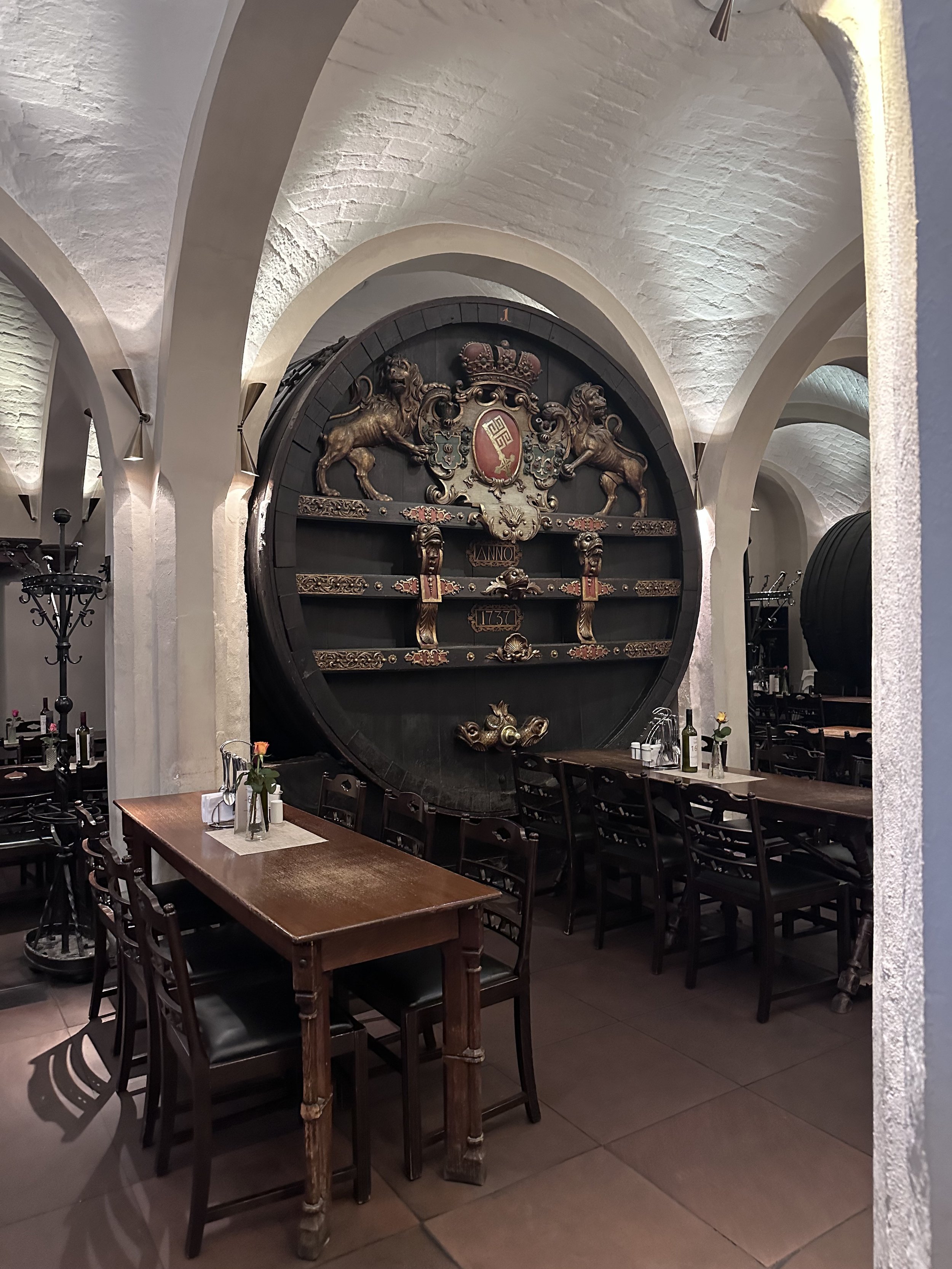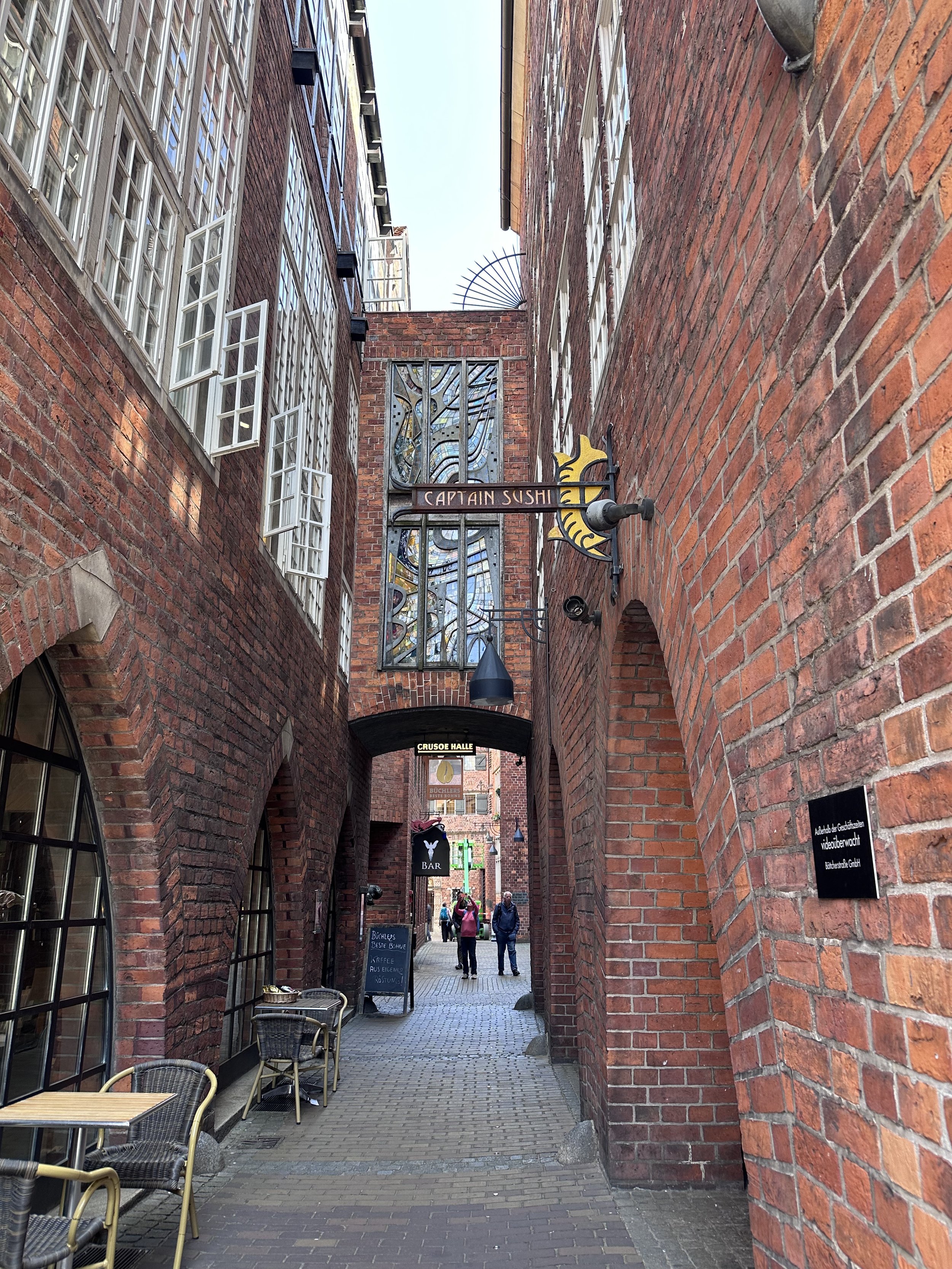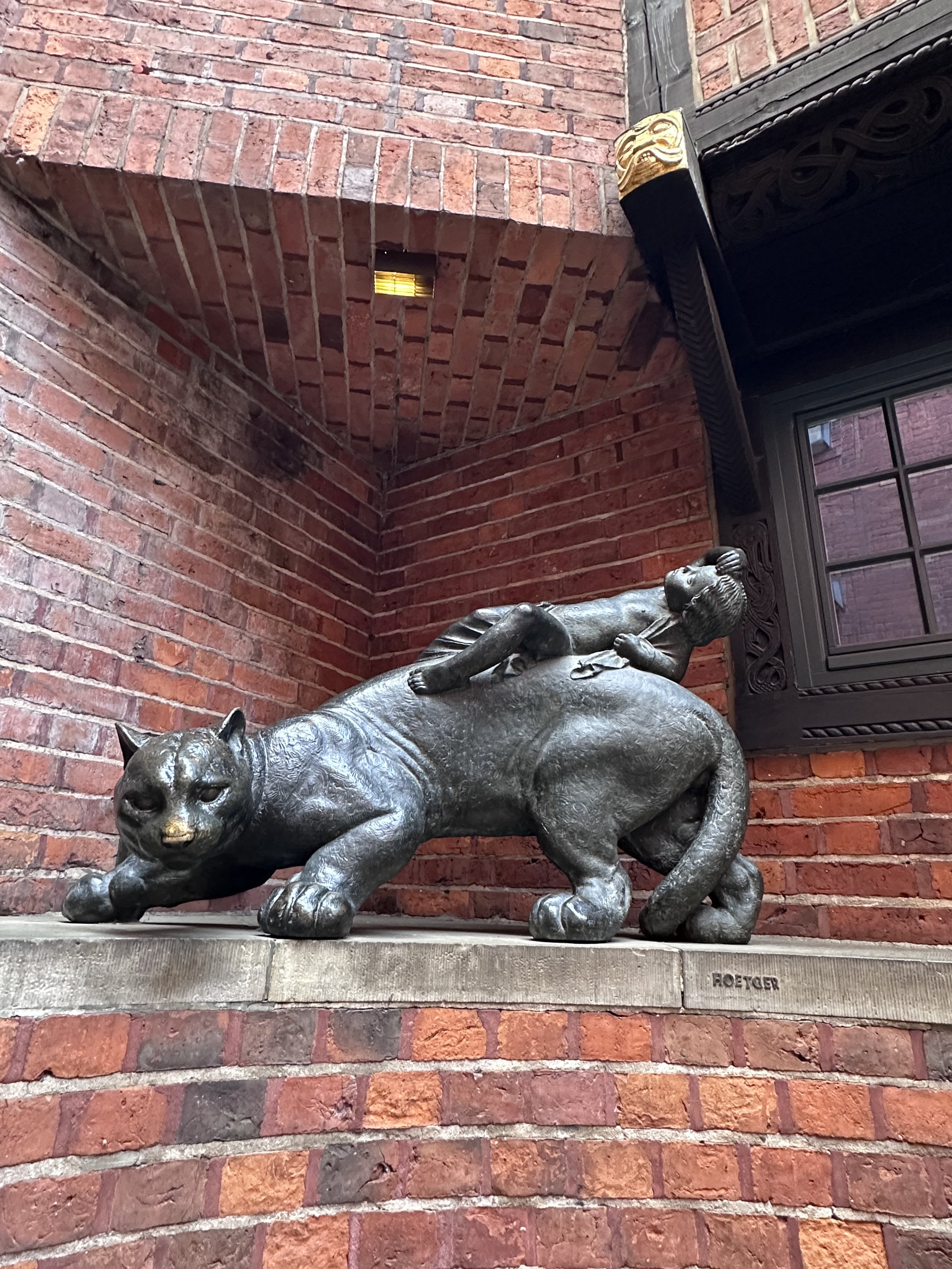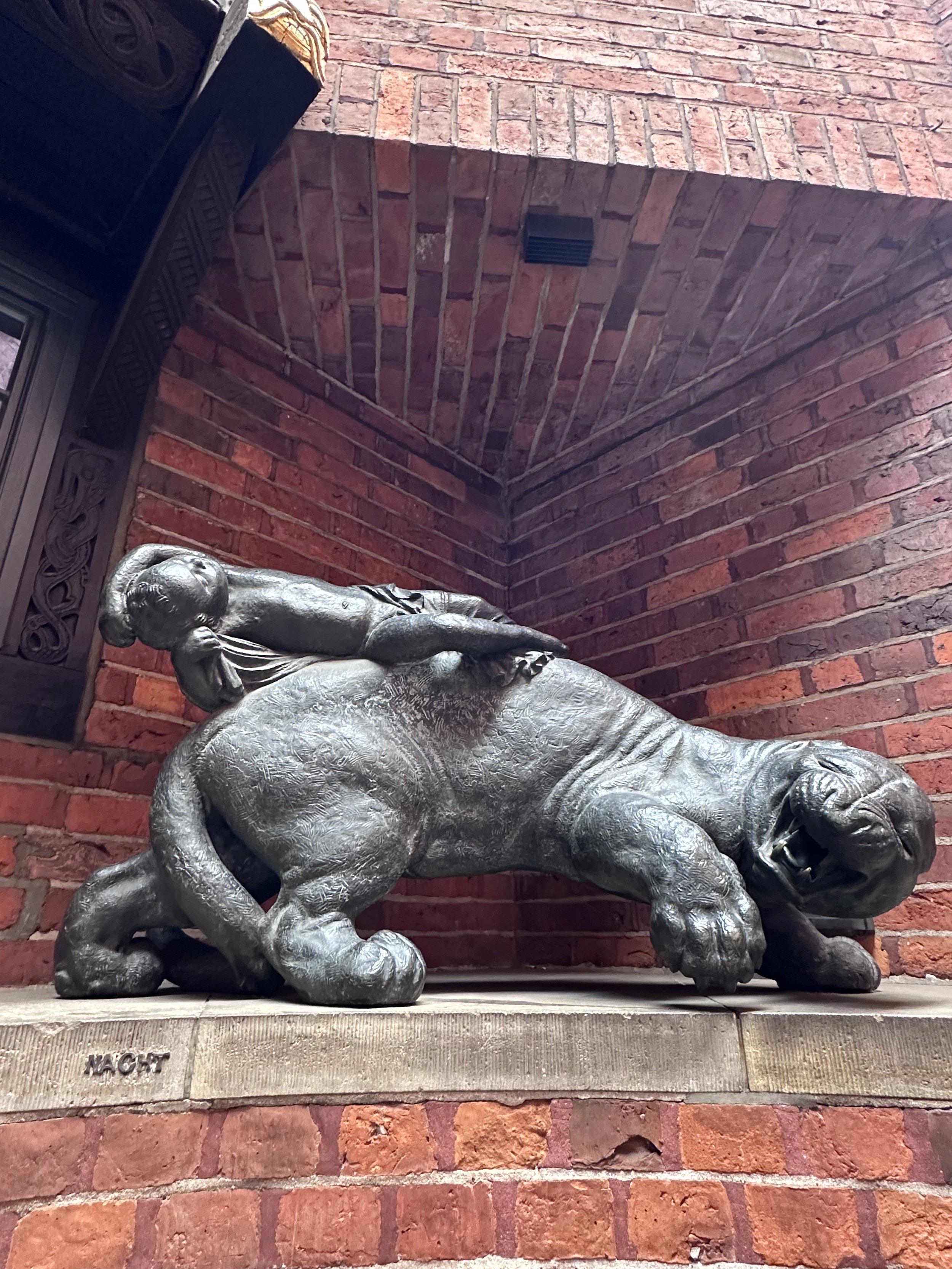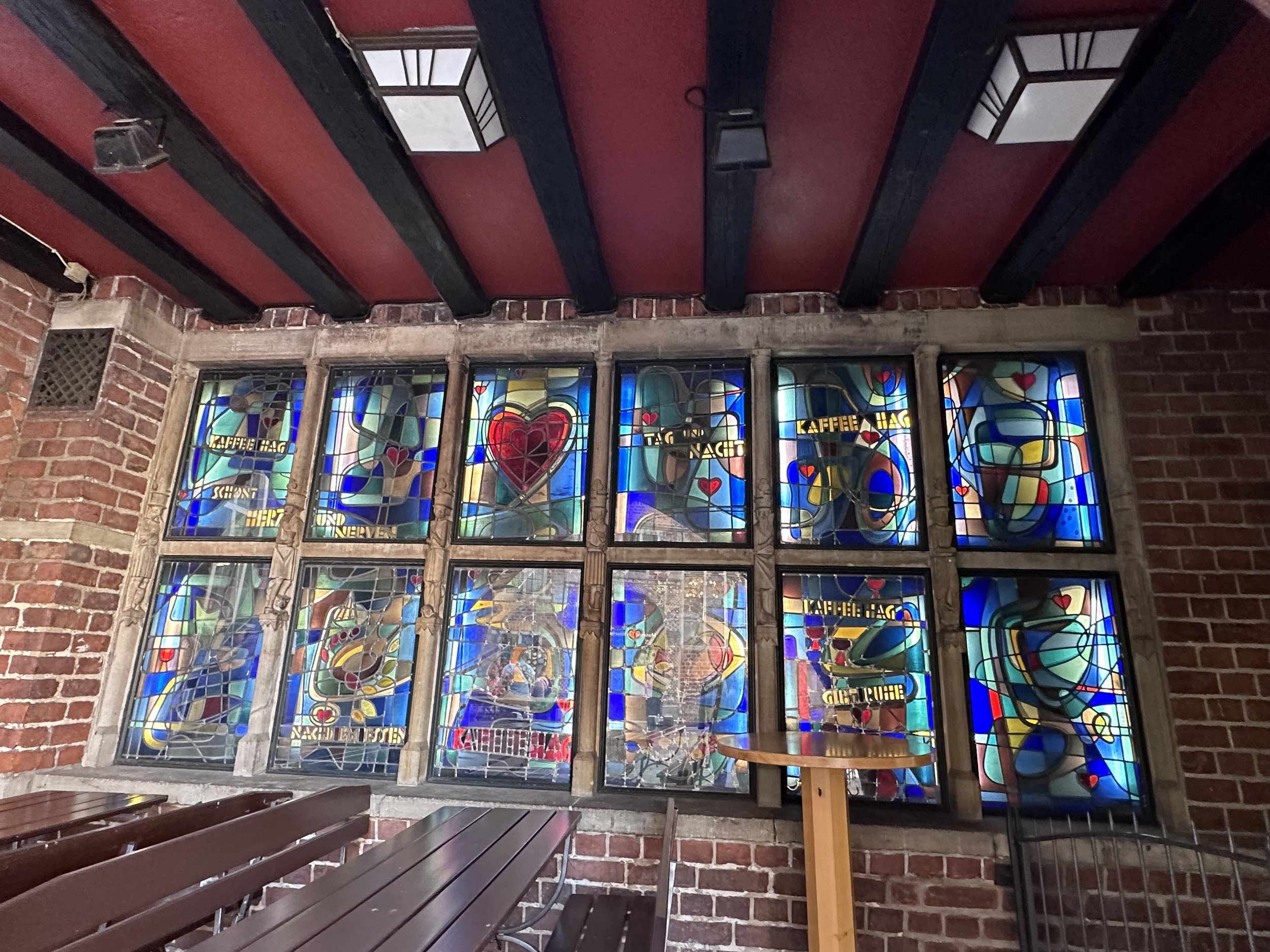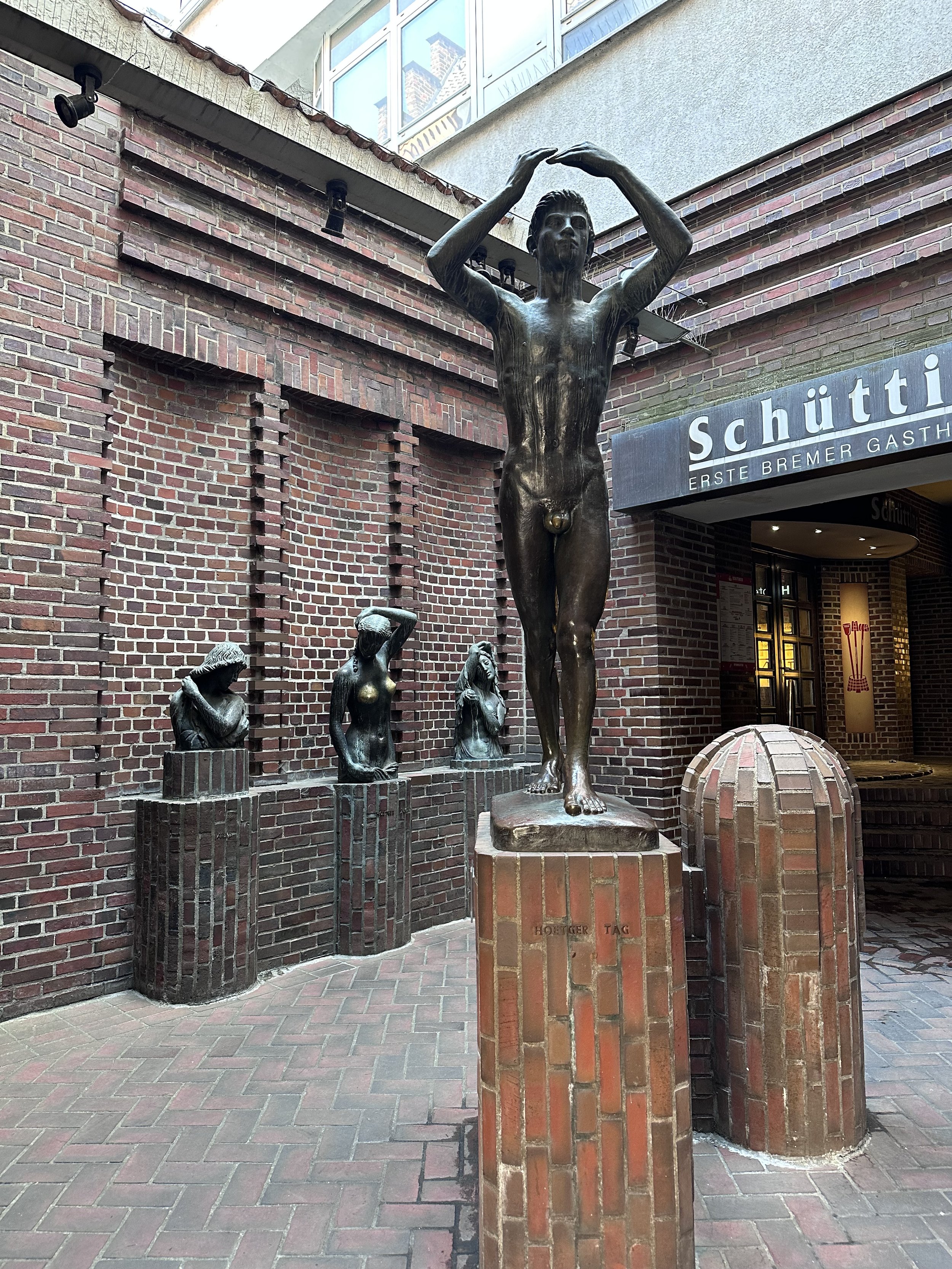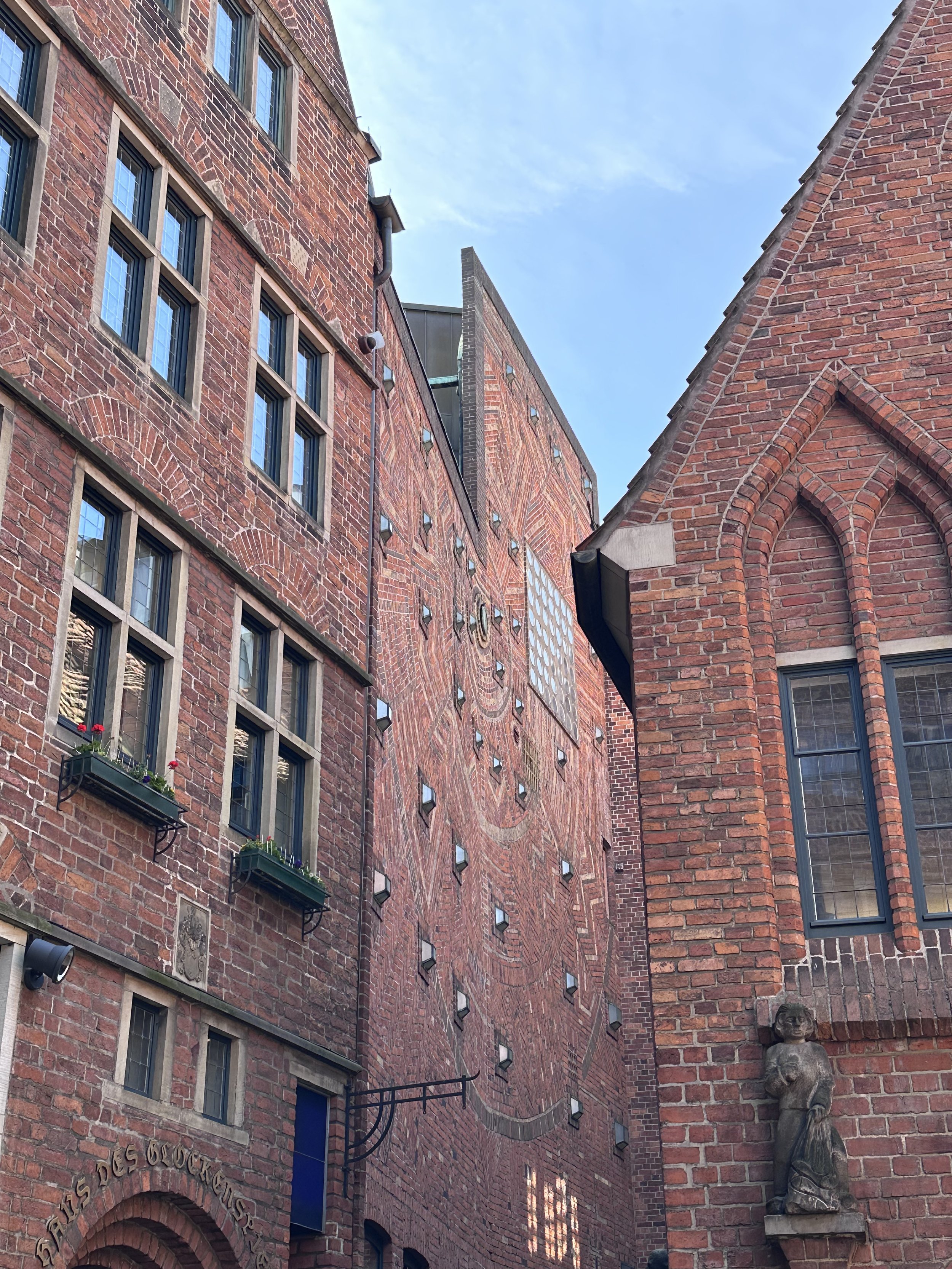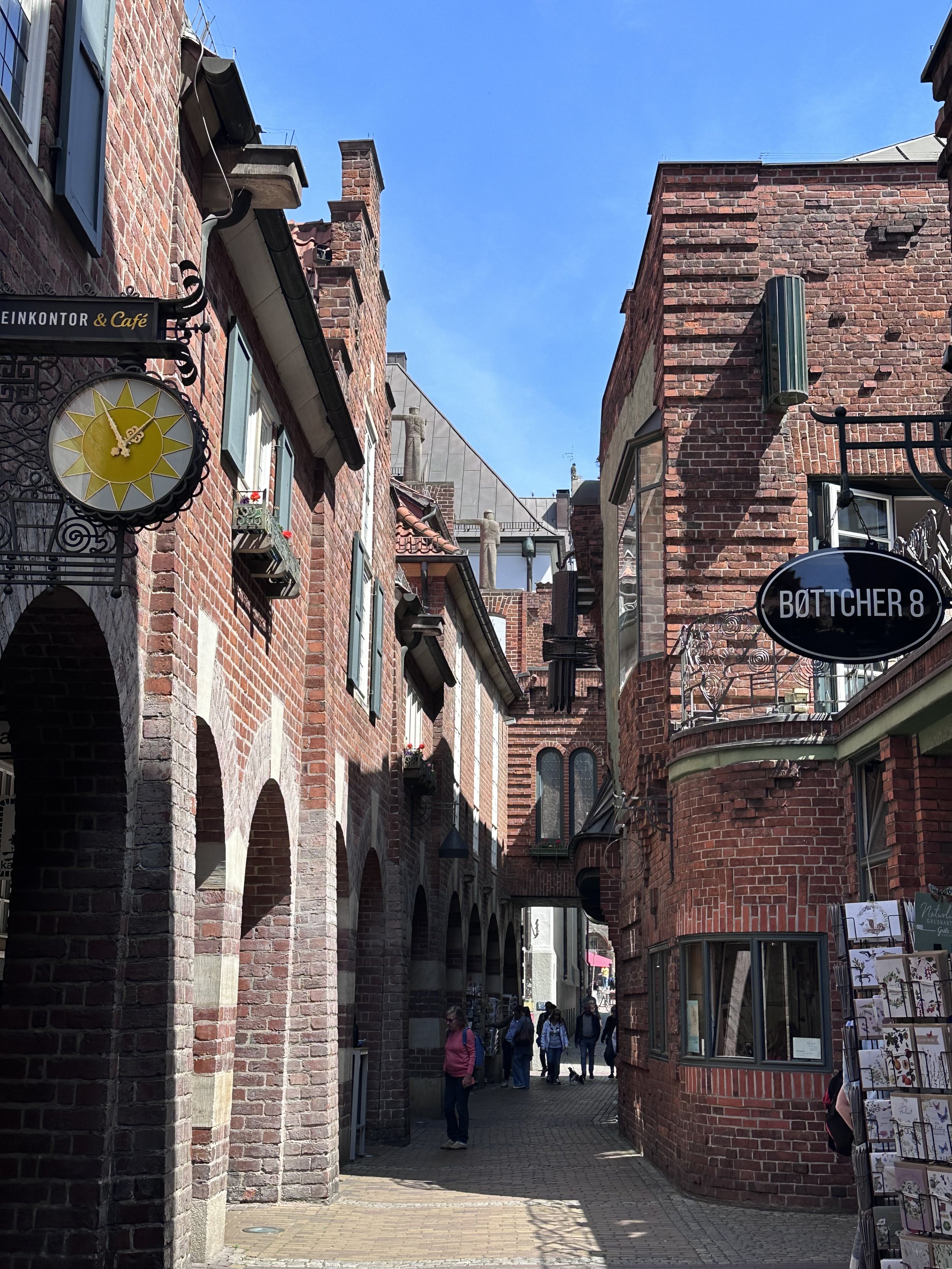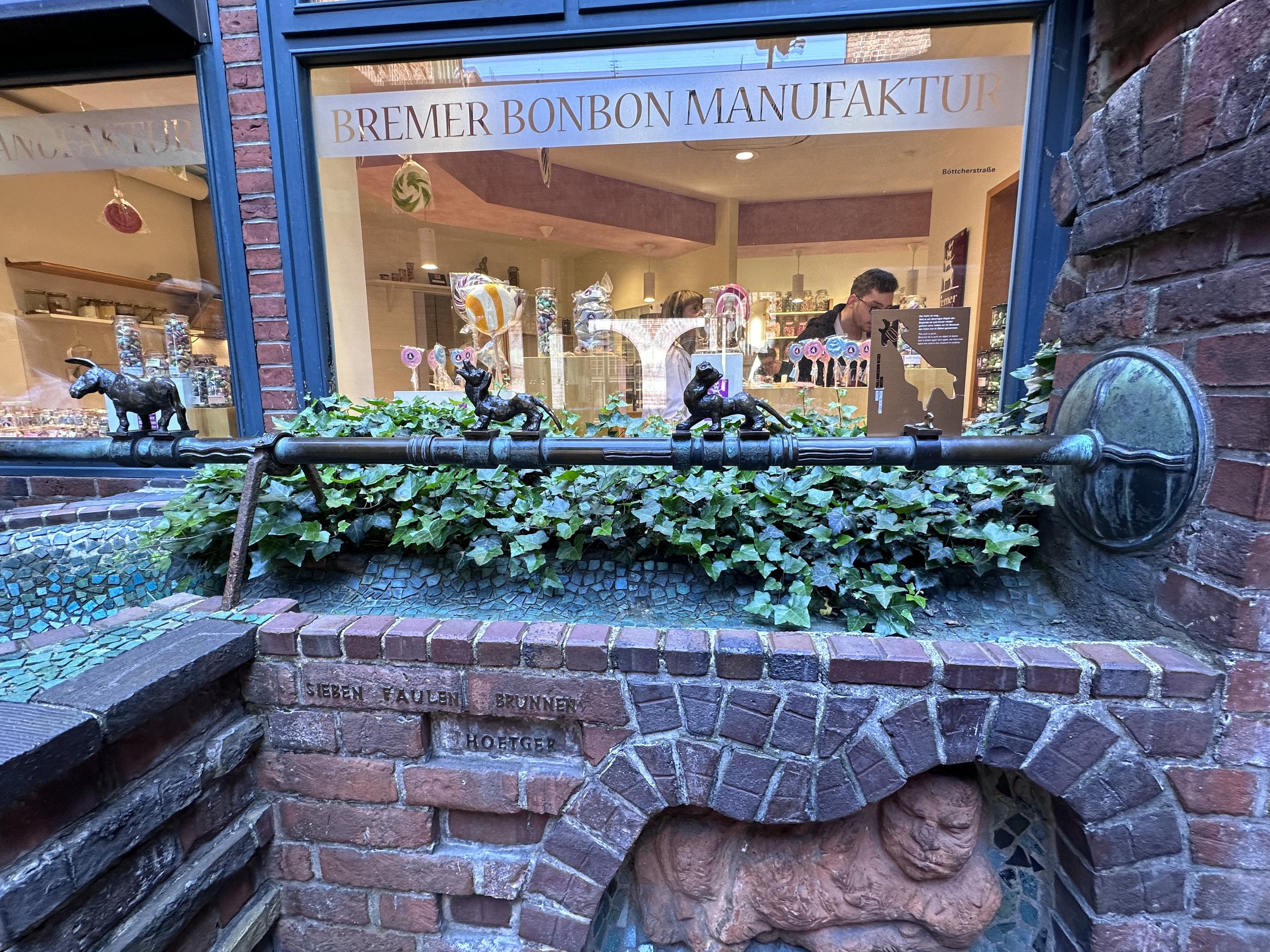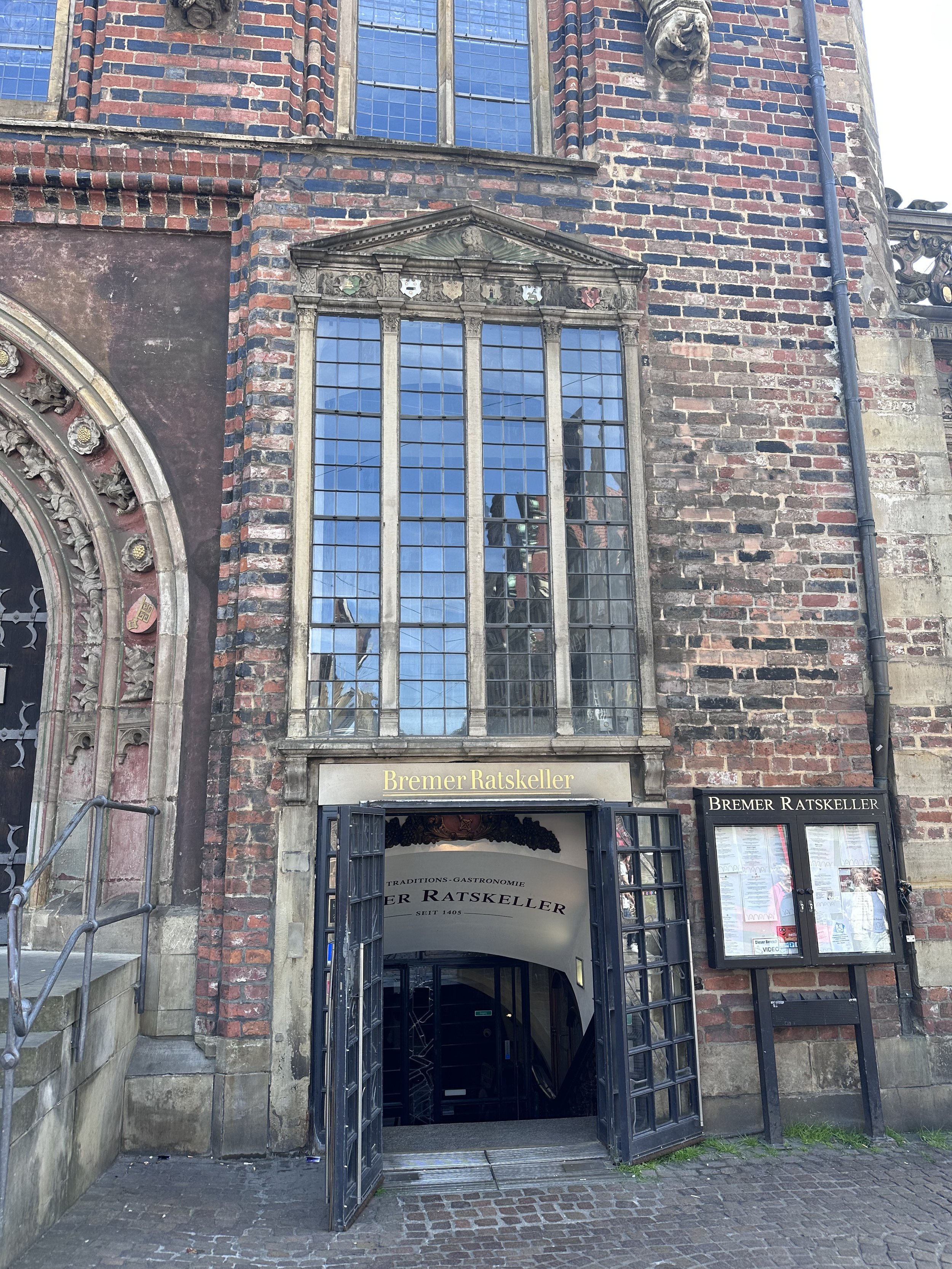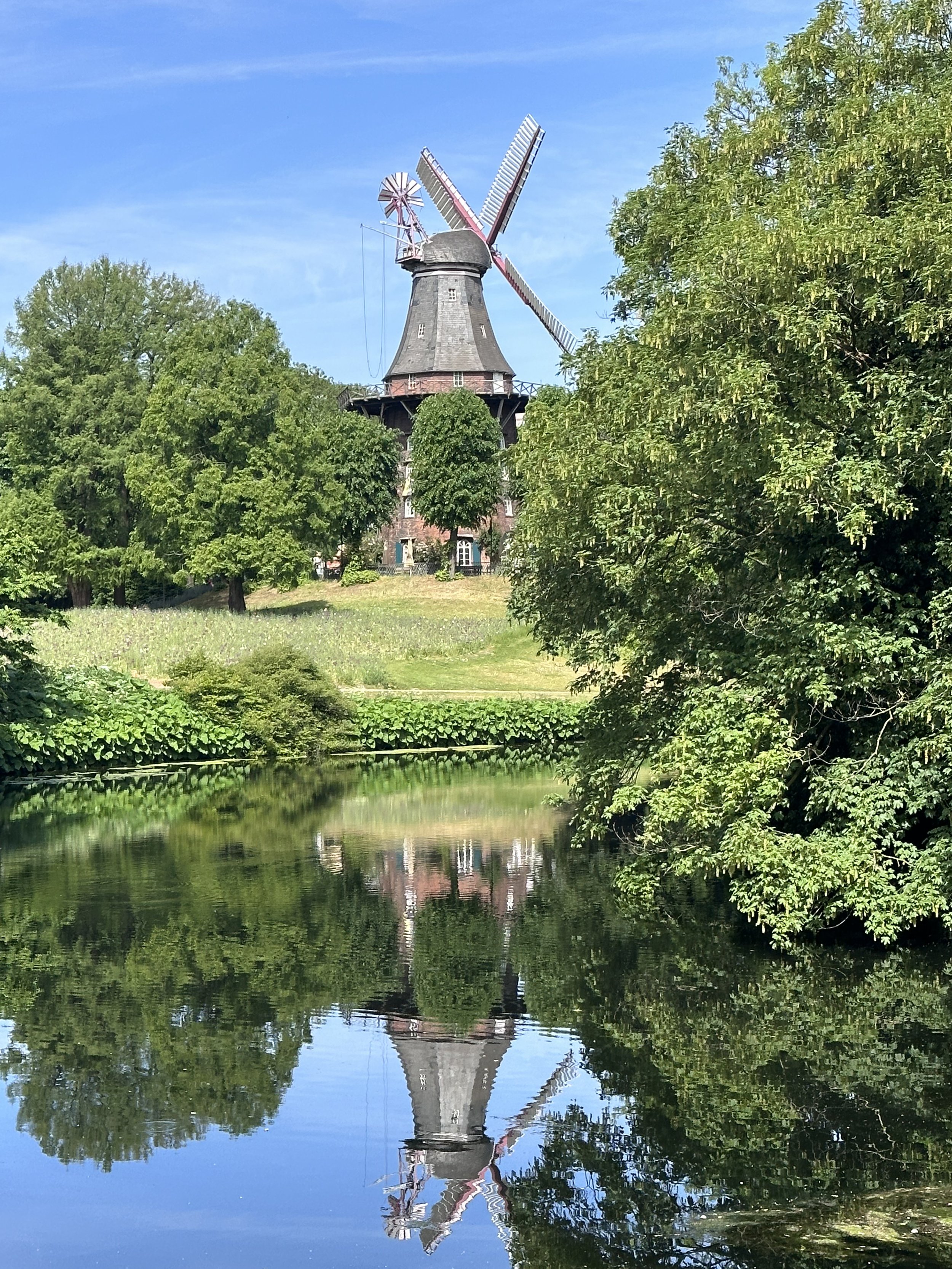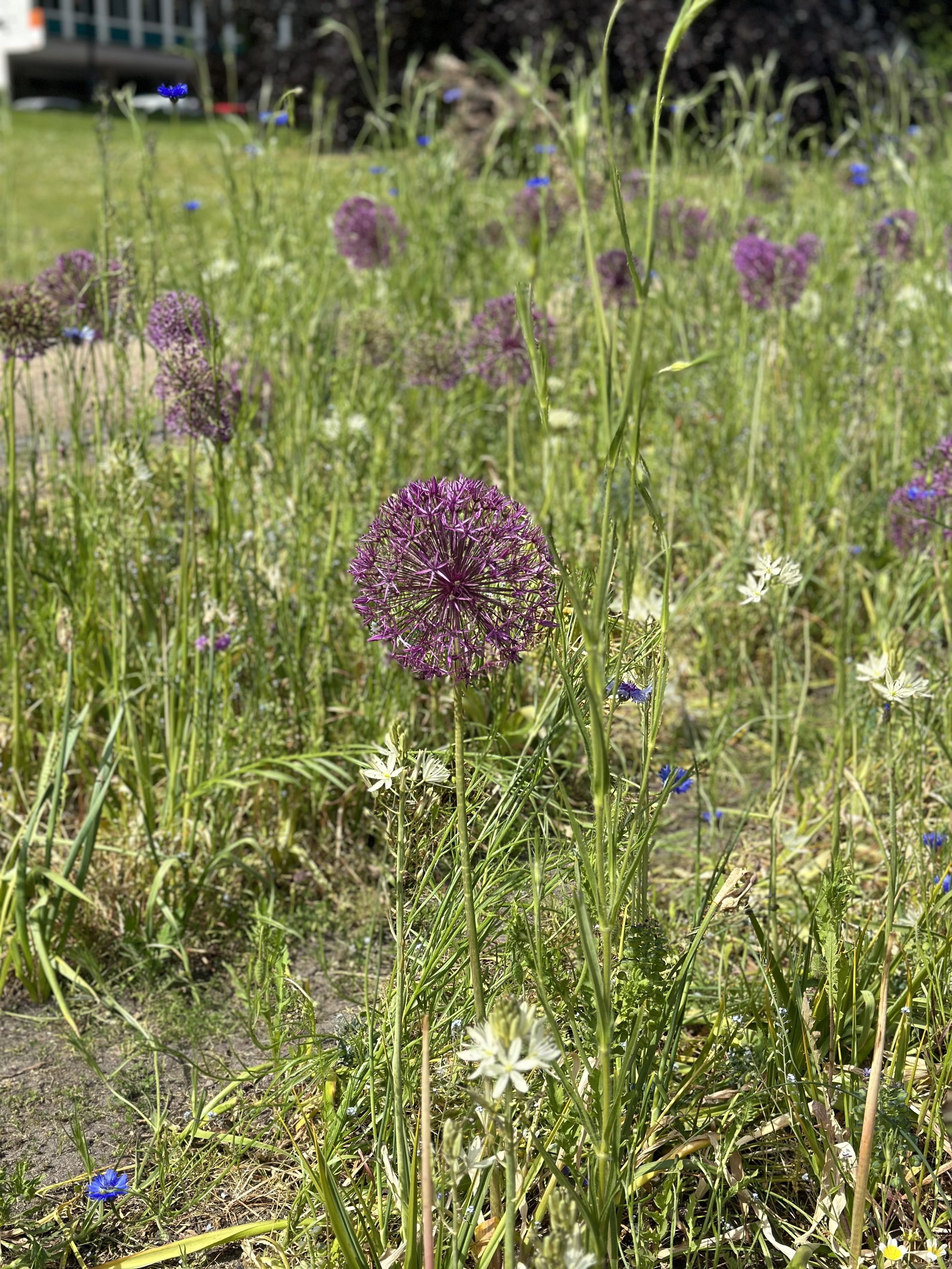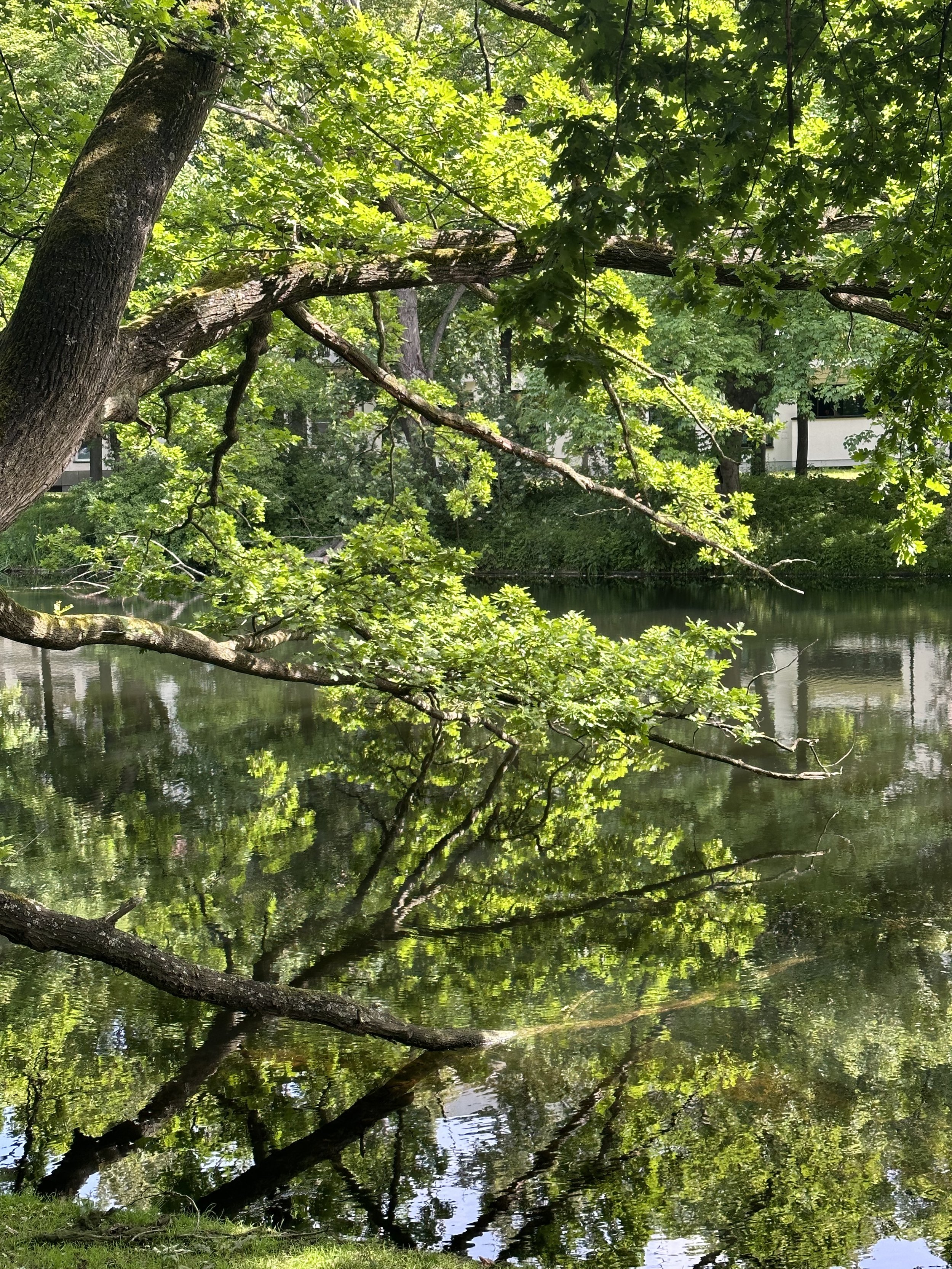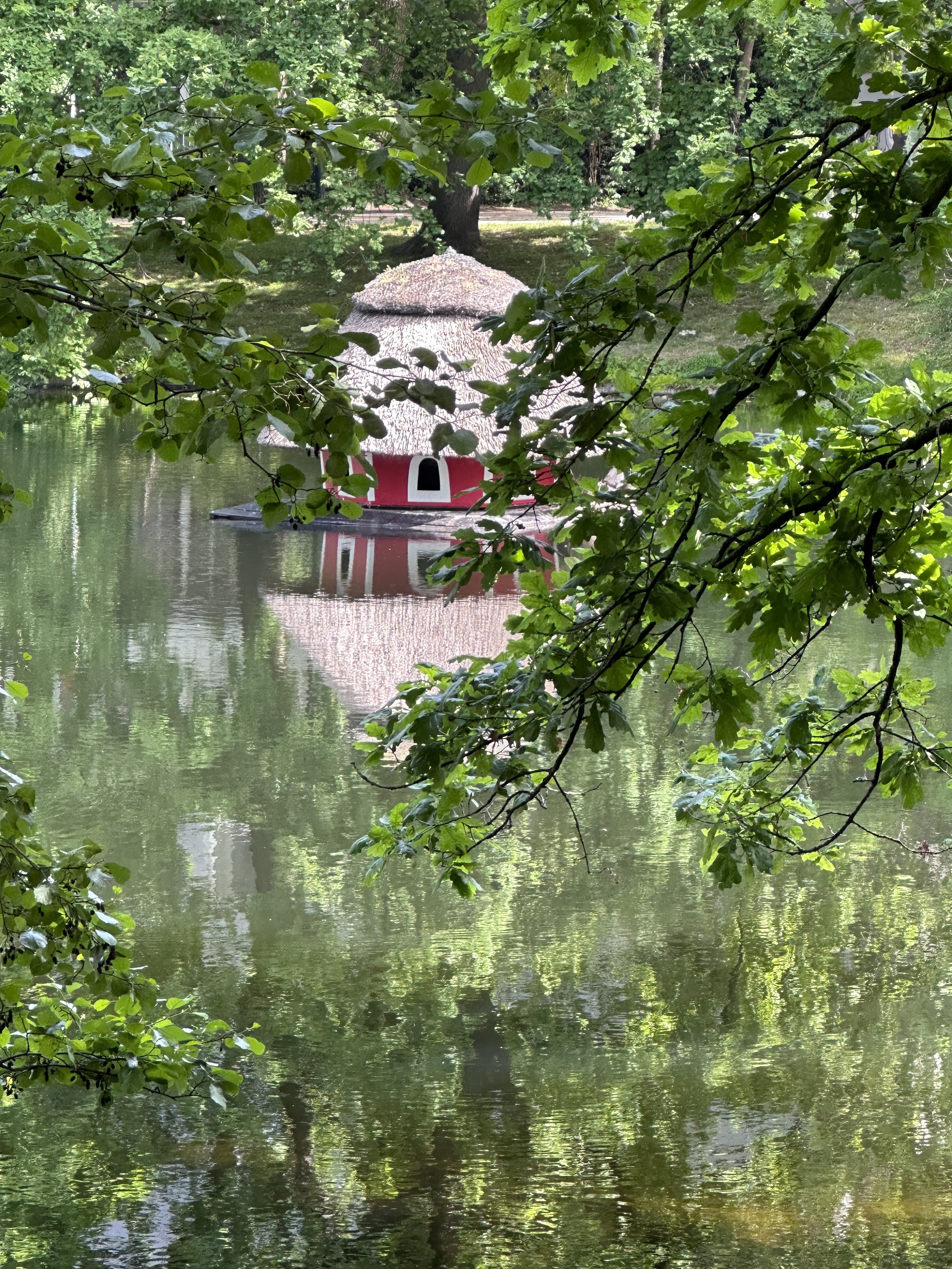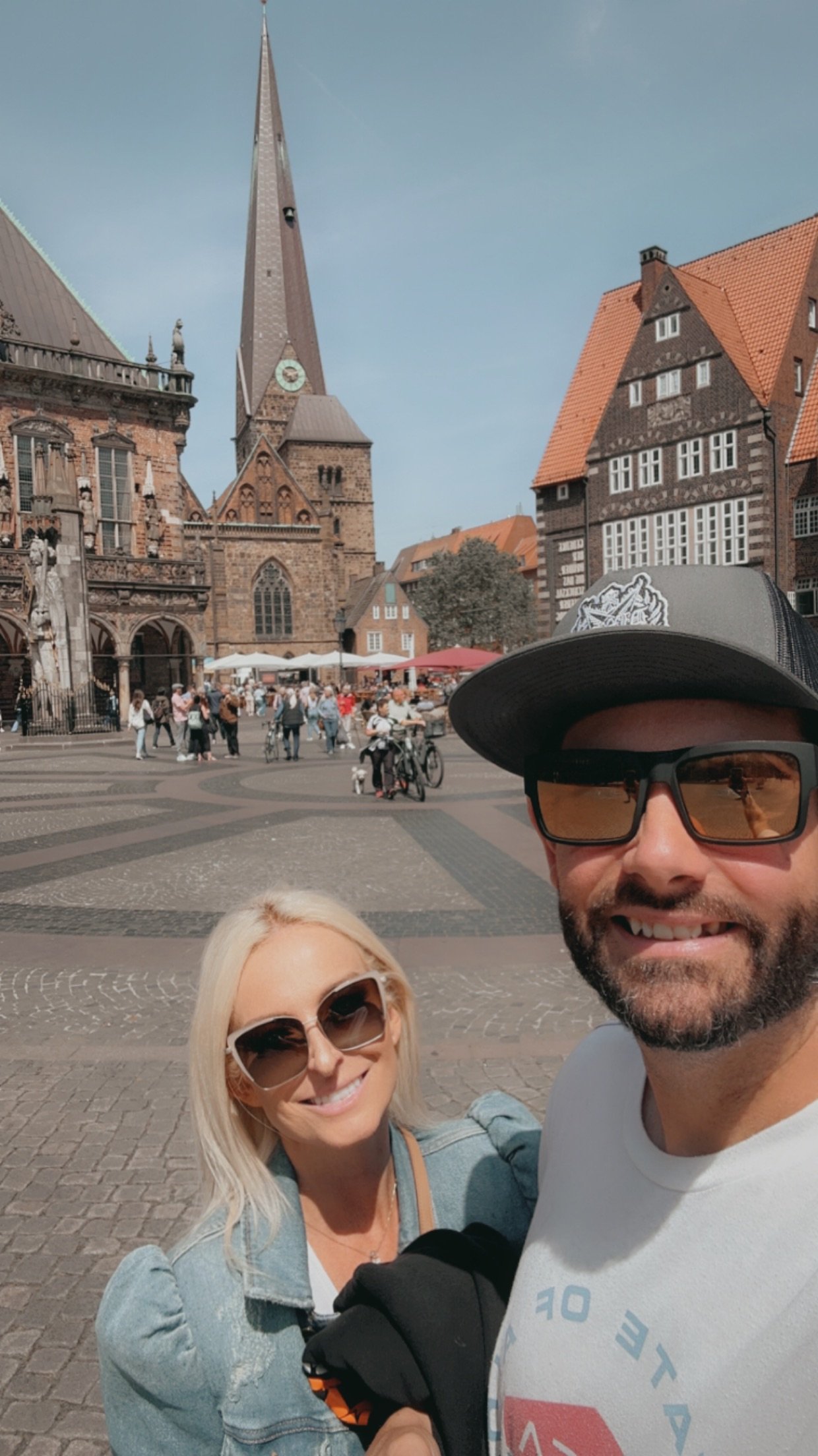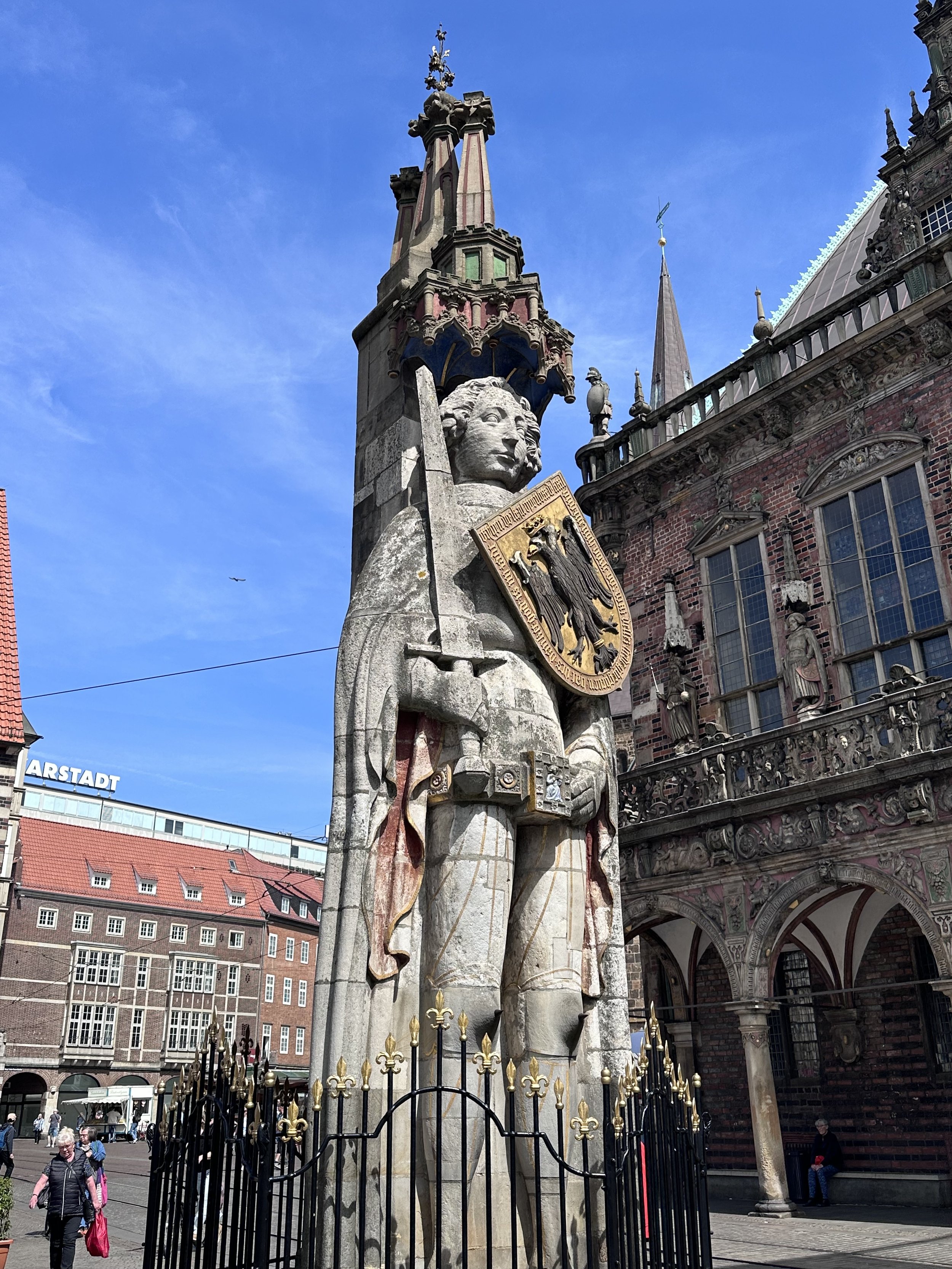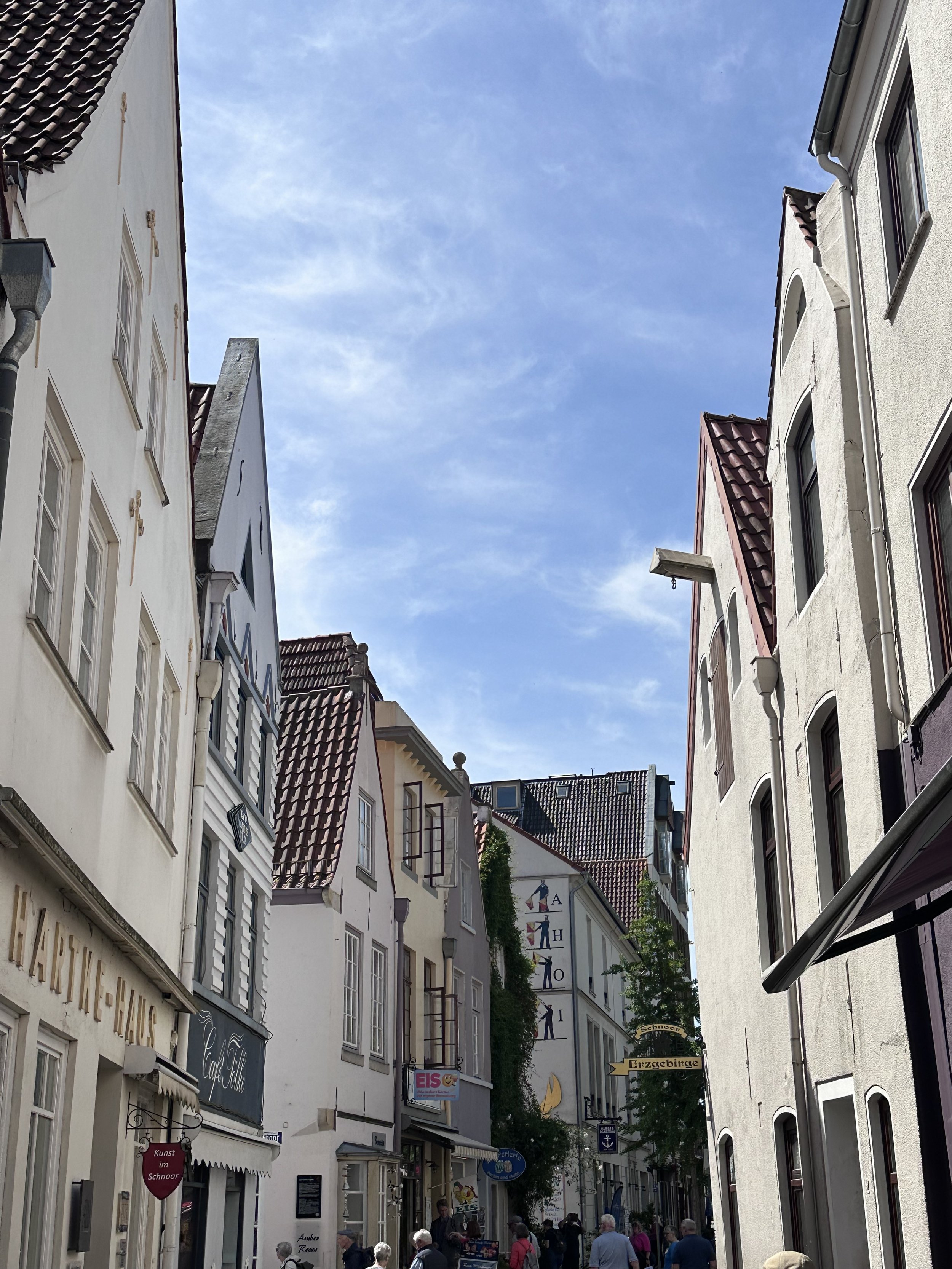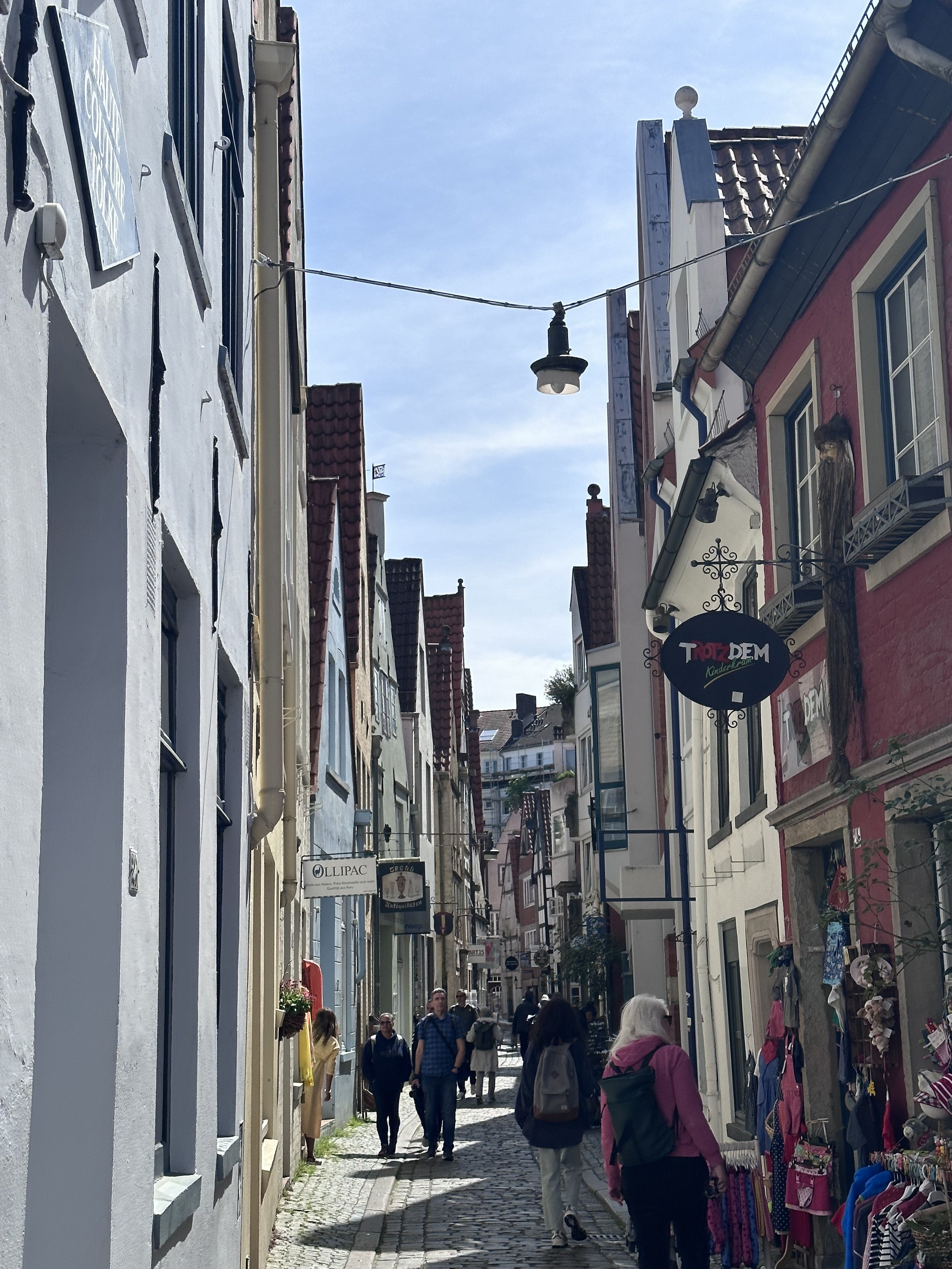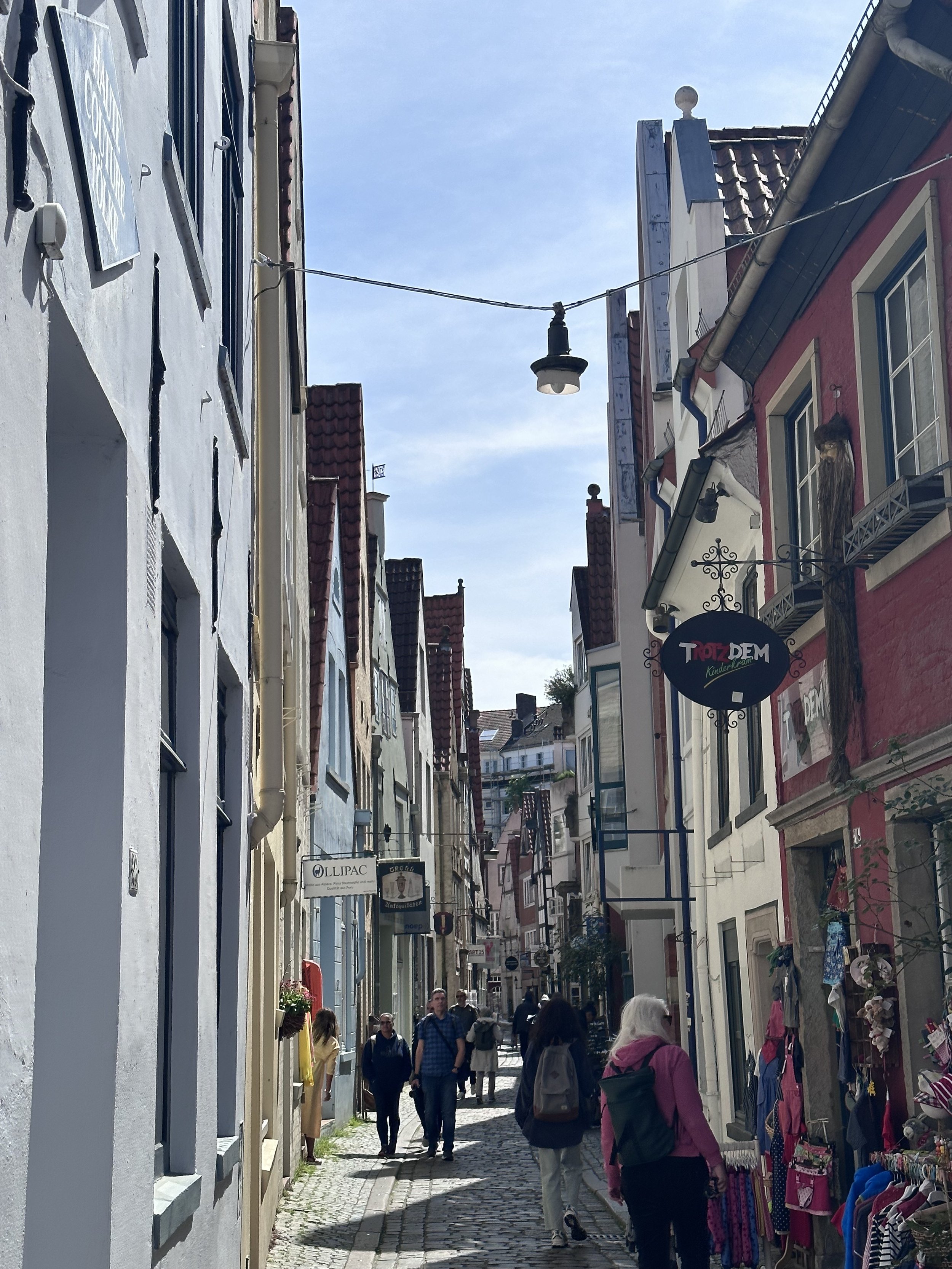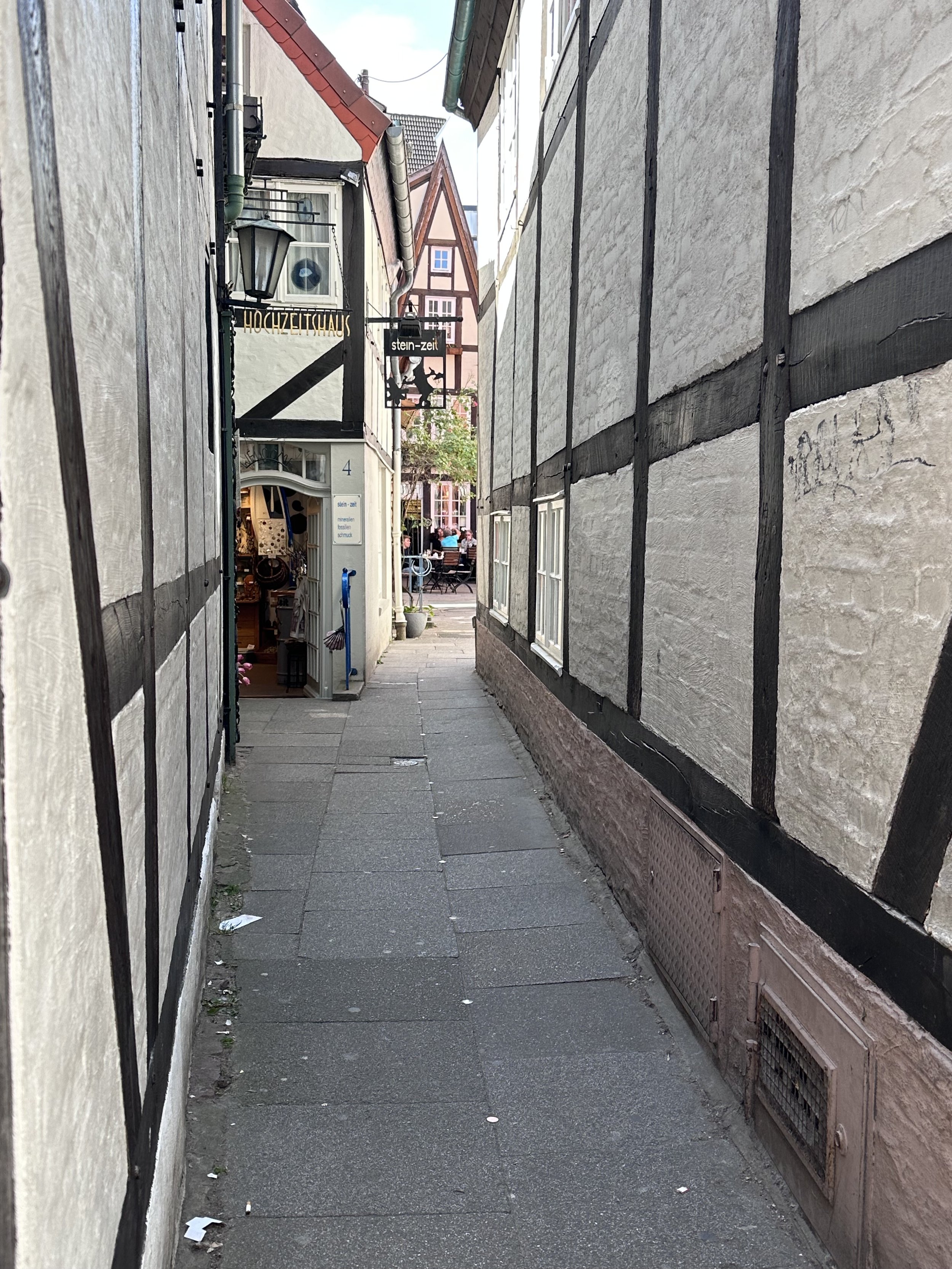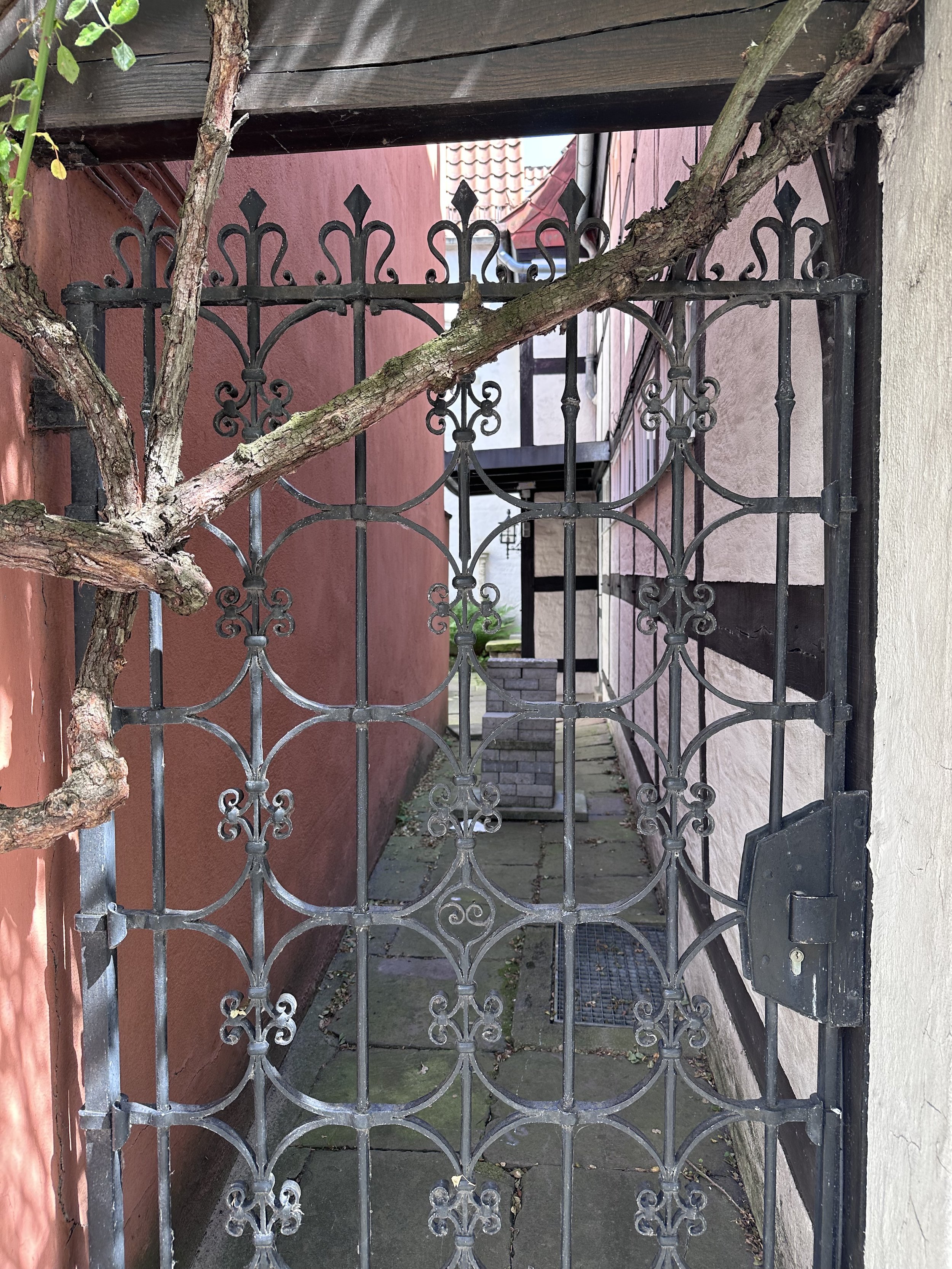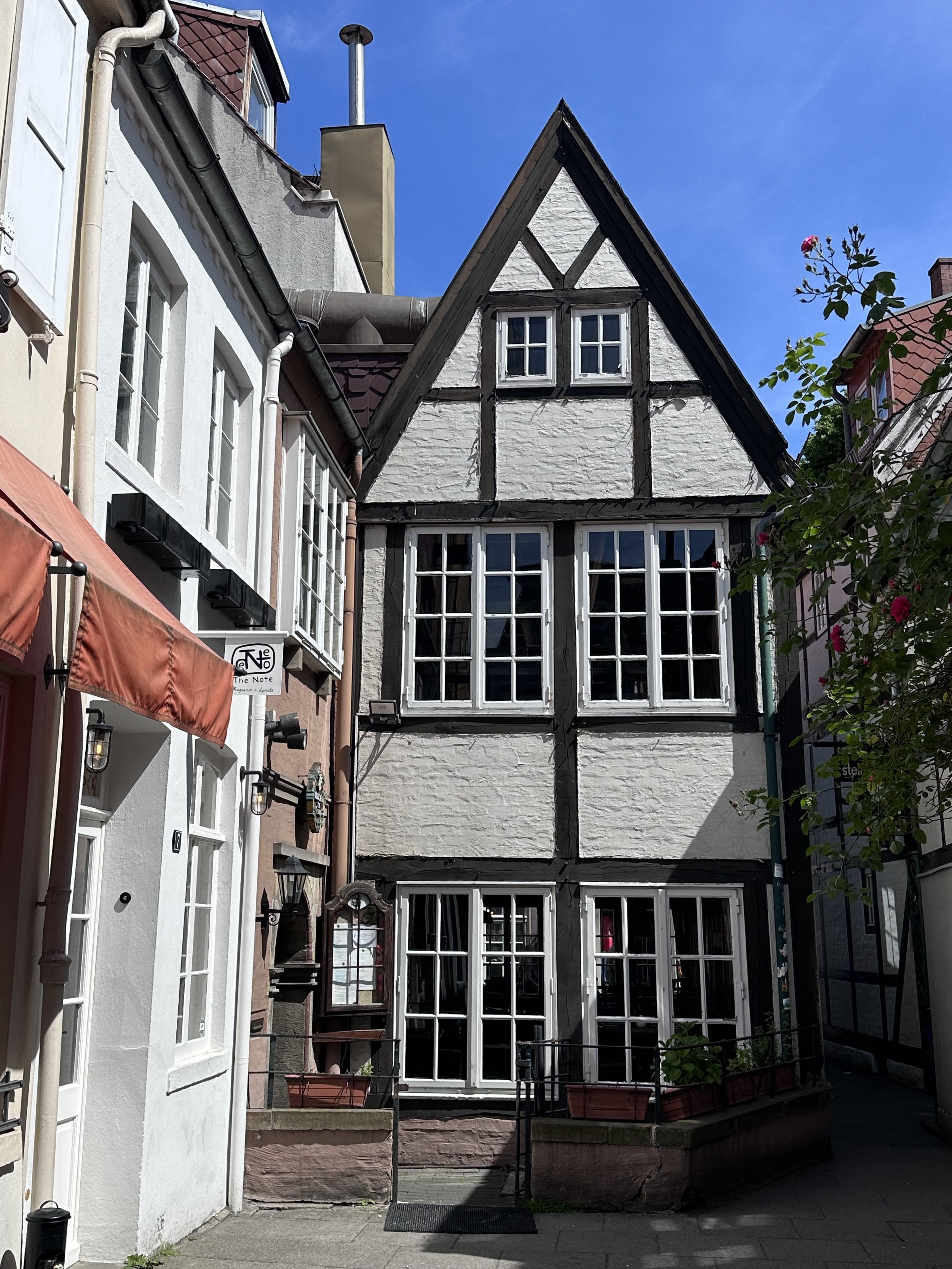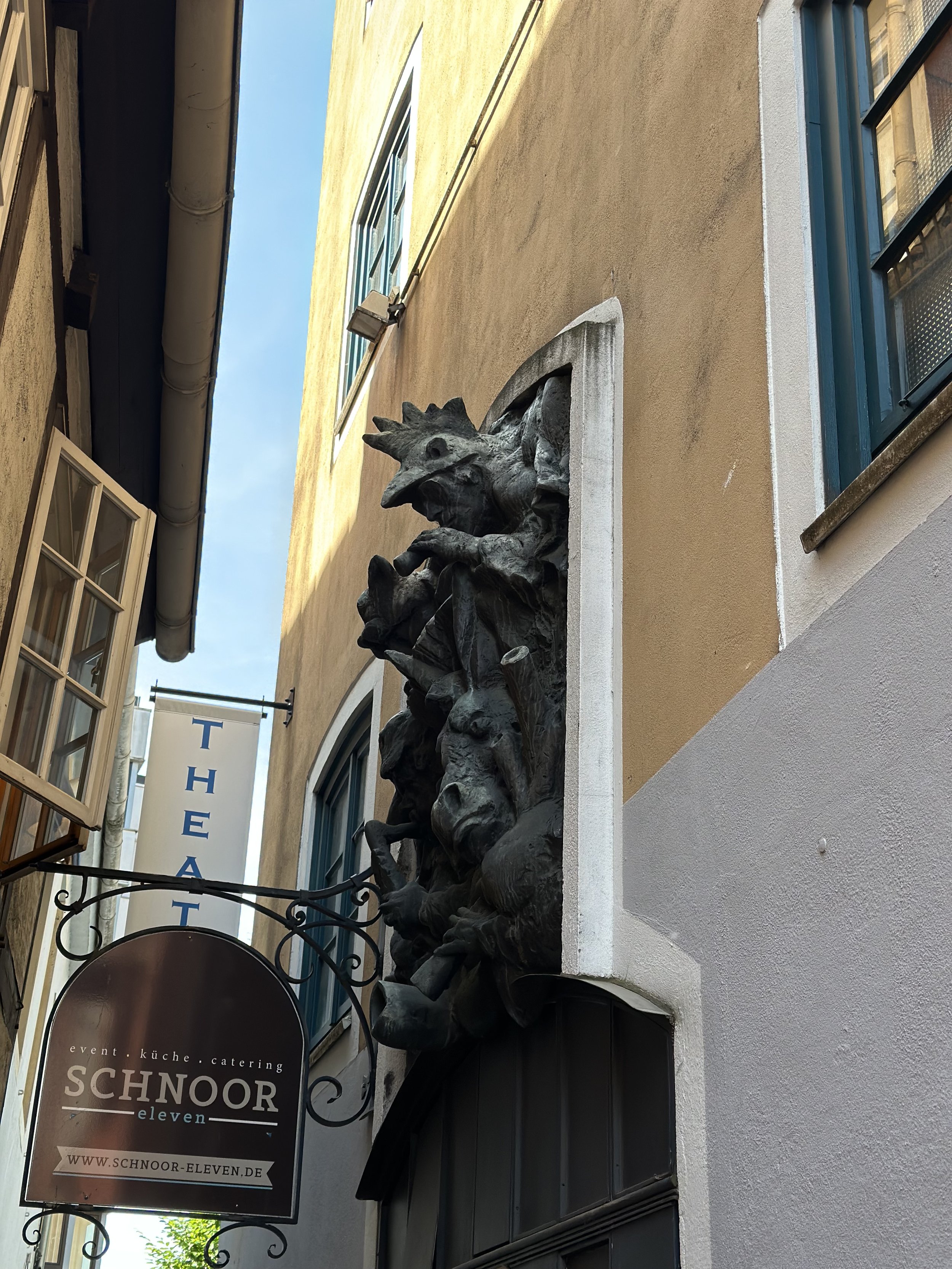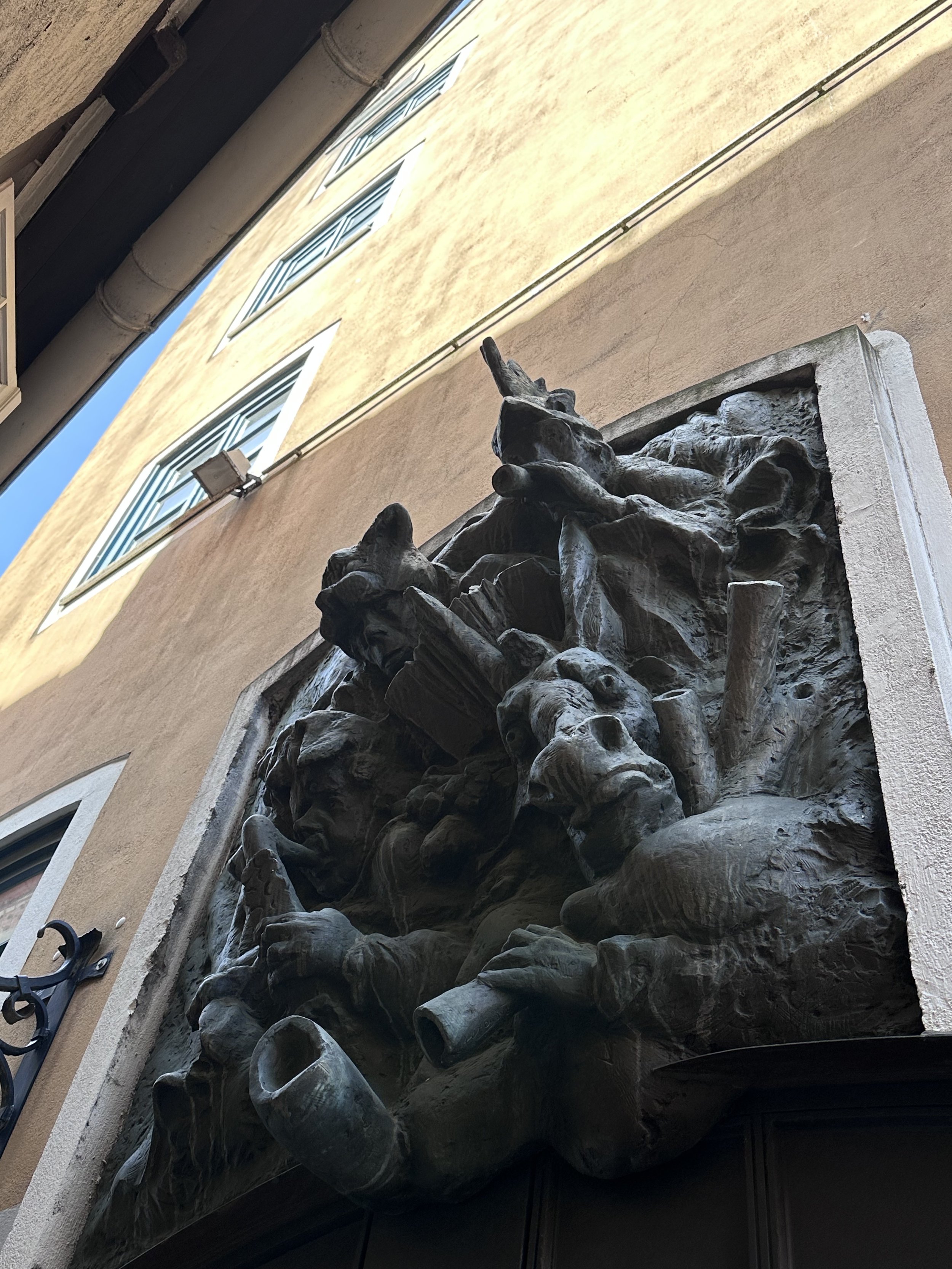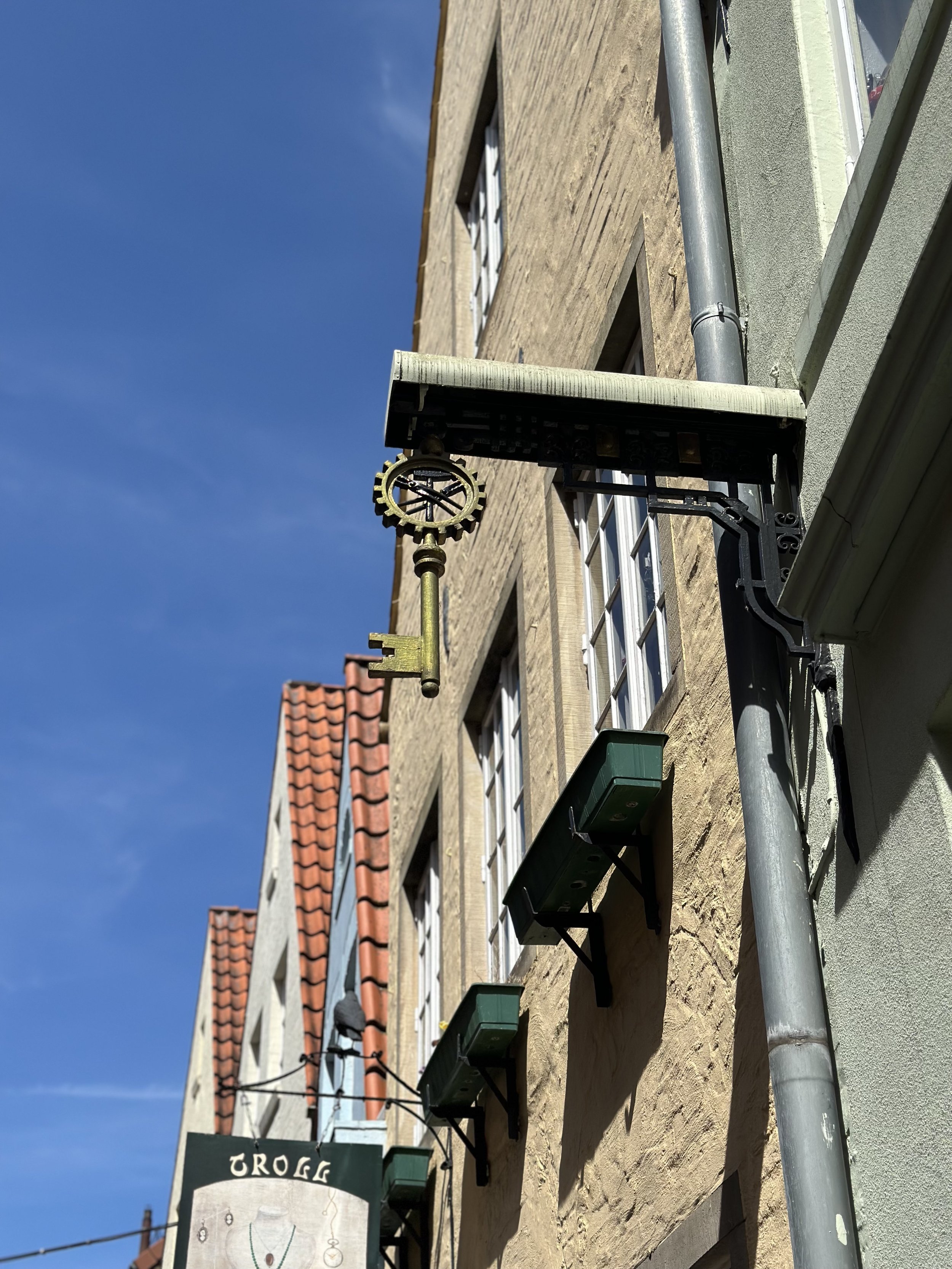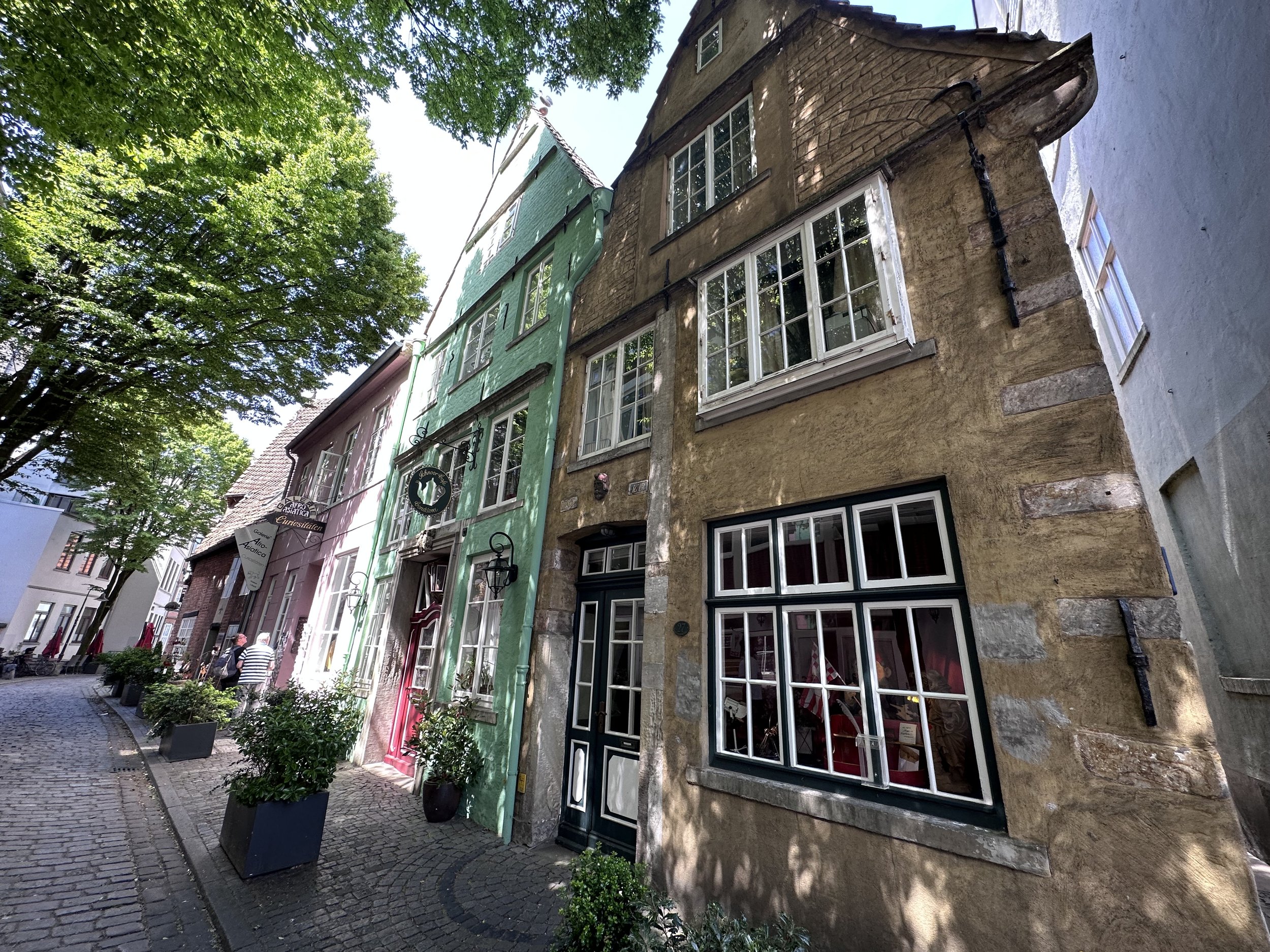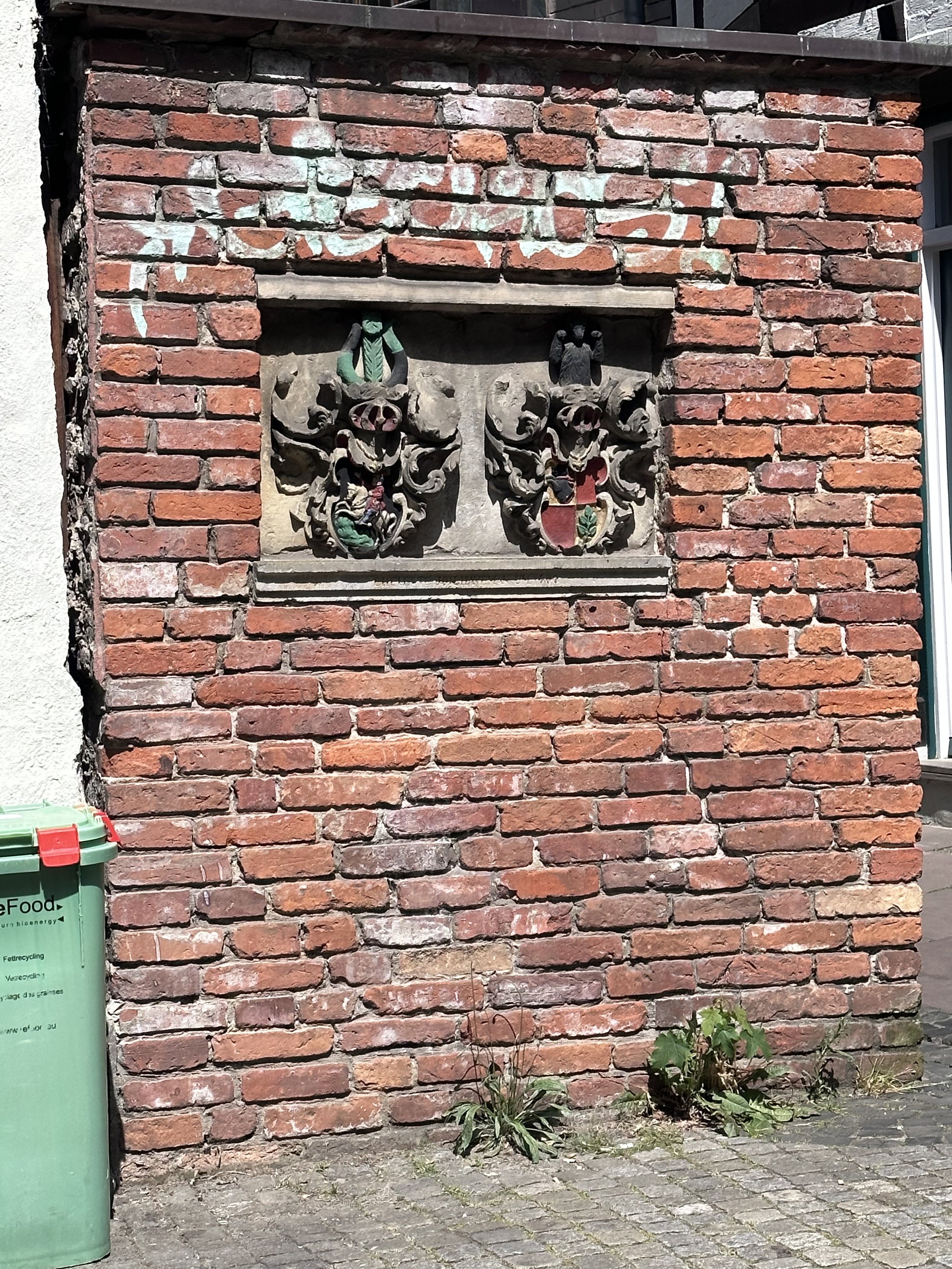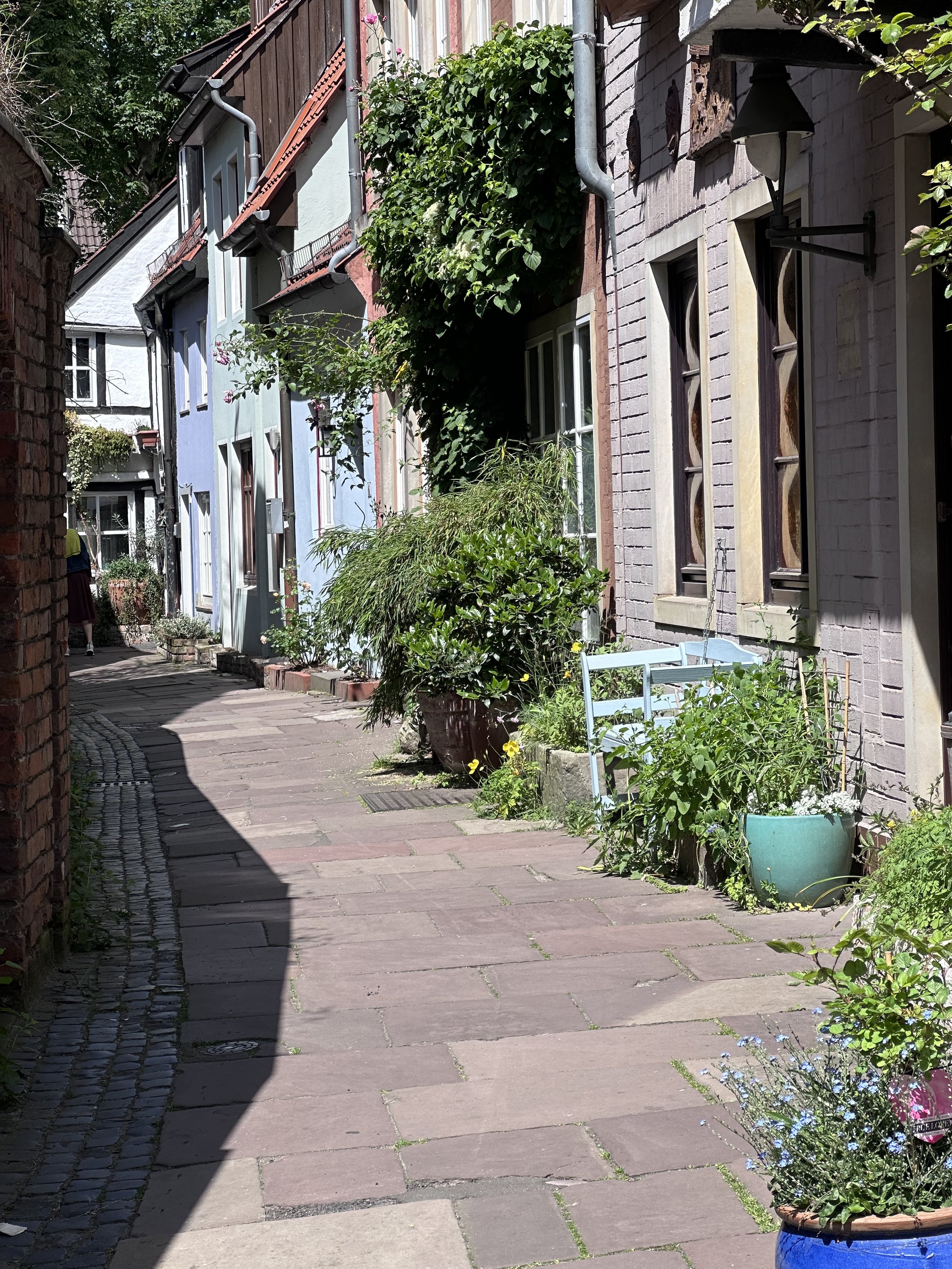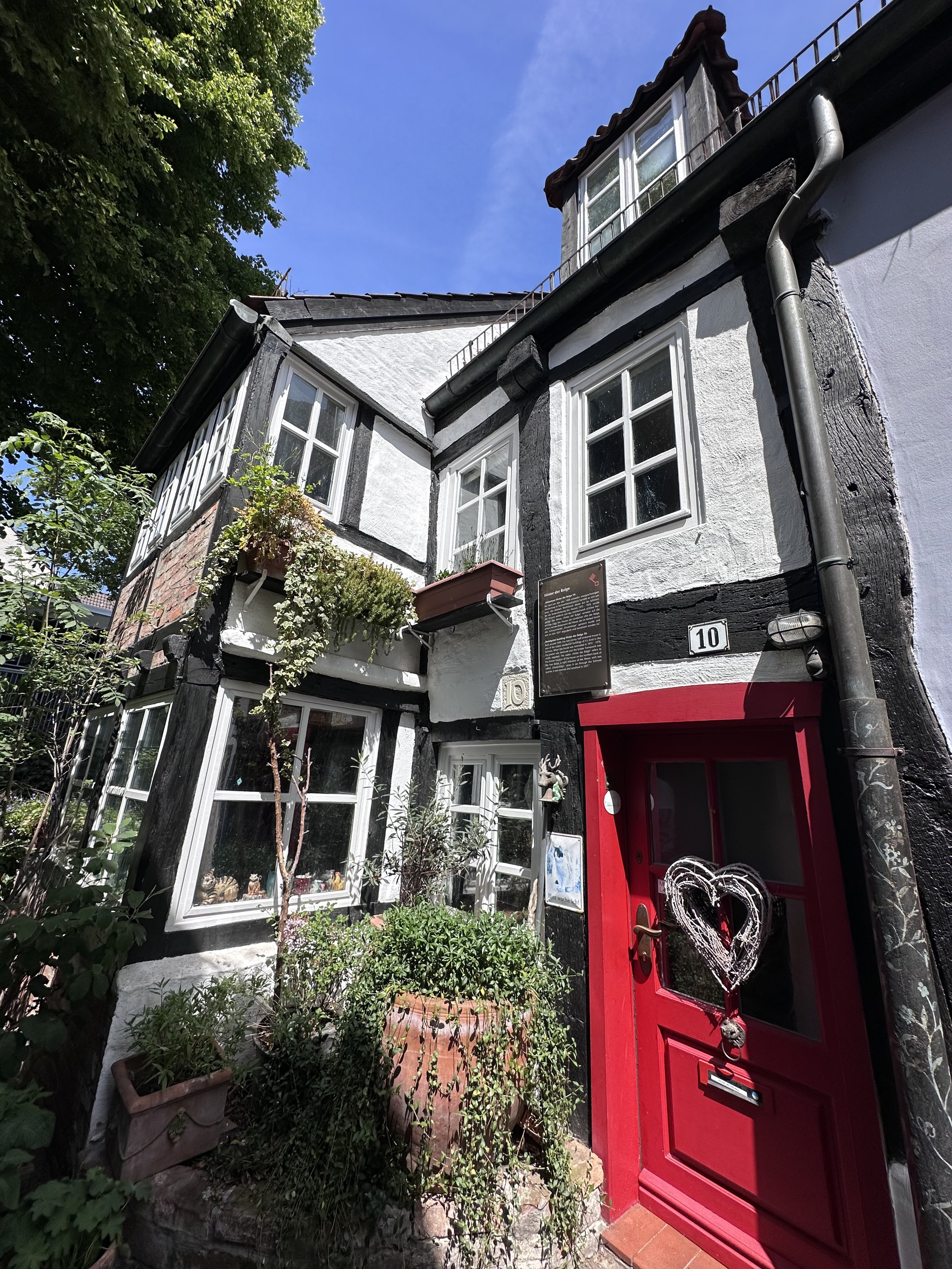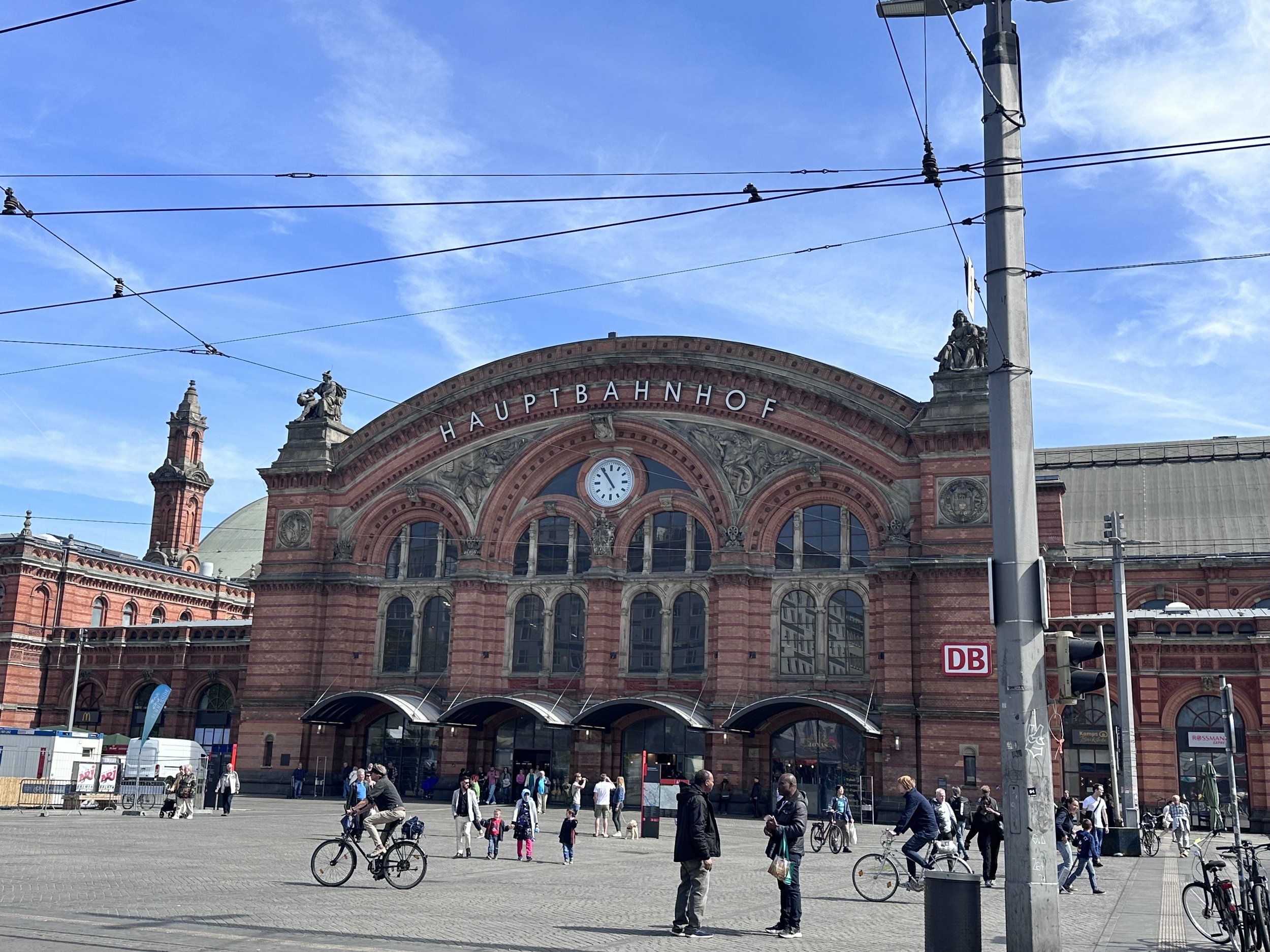Exploring Bremen, Germany
Schnoor area of Bremen
Bremen is the perfect dichotomy of modern, daily life and old world charm. Blackbeard and I didn’t know what to expect when we stepped off the train from Hamburg as we had heard the city is largely made up of Turkish and Syrian refugees, which is true in the modern part. But, you walk 3/4 of a mile towards the historic center and life suddenly becomes very different. The concrete buildings give way to old Bavarian buildings, porcelain bells, 1000 year-old statues, and many happy German people. We left there wishing we sought out more of these towns along our travels this time around. We agree that it is entirely worth the day trip but there’s no need to stay overnight as you can see it all in just a few hours.
The below information is a complete guide of the best places to stay, the top rated places to dine and drink, and all there is to see and do. We’ve also included transportation tips, as well as a summary of the history of this fairytale-like town.
Time needed in this town: 1 night
where to Stay
As you’ve read, we only did a day trip to Bremen, which is really all you need. However, if you choose to stay overnight, here is our list of recommendations:
STAYERY Bremen Am Wall (best-rated)
WHERE to Dine & drink
Das Kleine Lokal
Serving refined tasting menus (including a vegetarian option) plus international wines. They are open from 6pm - 11pm Thursday-Saturday.
Gaststätte Kleiner Olymp
Serving authentic Bremen cuisine. They are open from 5pm - 11:30pm.
Konditorei Café im Schnoor
We stopped into this authentic German bakery at the far end of Schnoor as we heard they had some gluten-free (gluten frei in German) baked goods. We do recommend a stop in there and if you’re gluten-free, the Baumkuchen halves and Schnoorroller were both excellent!
Küche 13
Serving meat and seafood dishes. They are open from 6pm - 1am.
La Bottega
Serving Italian cuisine. They are open from 11:30am - 8:30pm.
Market Hall Eight
Serving global fare in a food hall setting. They are open from 11am - 10pm.
Nora’s Deli
They offer healthy, fresh cuisine for lunch and dinner, which includes many gluten-free options. They are open from 12pm - 10pm.
Plaka Restaurant
Serving Greek cuisine. They are open from 11:30am - 2:30pm for lunch and 5:30pm - 10:00pm for dinner.
Q1 - Metropolitan Kitchen & Bar
Serving inventive, artfully plated fusion cuisine. They are open from 12pm - 11pm.
Ratskeller
Their wine cellar has been around for over 600 years (find a day when they do their cellar tour and wine tastin). Sip on their stash and dine on North German classics, as well as light and modern cuisines. It is part of the City Hall UNESCO Heritage site.
NOTE: We canceled our reservations there because their lunch menu ended up being super limited with no real way to adjust for Celiac. However, if you have no dietary restrictions, it’s definitely a must!
TIP: Go on a day when their cellar is open and they are doing wine tastings! You can do that separately from dining. If you miss the tasting days, they have a pop-up tasting room in the middle of the town square that you can’t miss.
Restaurant Tendüre
Serving Turkish specialties, from meze platters to kebabs. They are open from 12pm - 3pm for lunch, and 6pm-11pm for dinner.
Savarin
Servinge Spanish cuisine. They are open from 6pm - 10pm.
Schröters Leib & Seele
Servinge modern Mediterranean and German cuisine. They are open from 12pm - 3pm for lunch and 6pm - 11pm for dinner.
SoulM8
Serving sushi, noodle soups, and other Asian fare served in a former monastery. They are open from 12pm - 3pm for lunch and 5:30pm - 11pm for dinner.
Südtiroler Hütte
Serving dumplings, wiener schnitzel, and goulash, They are open from 4pm - 11pm.
Vengo die Gemüseküche
Serving vegetarian cuisine, and even offer gluten-free pasta. They are open from 12pm - 9pm.
Things to See/Do
Historical Tours
Böttcherstraße
The history of Böttcherstraße goes back to the Middle Ages. The historic street constituted an important link between the market square and the Weser river until the harbor was relocated in the mid-19th century. In 1902, Ludwig Roselius bought the house at 6 Böttcherstraße (today's Ludwig Roselius Museum) and made it the headquarters of his company, which would later produce the HAG coffee brand. He bought other lots on the street in the years thereafter. In 1926, he had the Paula Modersohn-Becker-Haus built to serve as a museum dedicated to the painter Paula Modersohn-Becker. In 1931, both the Atlantis House (Haus Atlantis) and the Robinson Crusoe House (Robinson-Crusoe Haus) were both completed. In 1944, large proportions of Böttcherstraße were destroyed by aerial bombings in WWII. By 1954, the Kaffee HAG company had restored most of the facades to their original state. In 1979, Ludwig Roselius Jr. sold the Kaffee HAG company, along with Böttcherstraße, to General Foods. Two years later, he bought Böttcherstraße back. In 1989, it was falling into disrepair, so Sparkasse Bremen Bank bought the whole street and all its buildings, except Haus Atlantis. Restoration was completed by 1999. In 2004, ownership passed to a foundation (Stiftung Bremer Sparer Dank). Today, it contains several art museums, arts and crafts workshops, bars, restaurants, shops, and a hotel. Nearly all the buildings and plots are owned by the foundation.
Bremen Town Hall
Bremen's original town hall had been situated in the southern end of the block between Liebfrauenkirchhof ("Our Dear Lady's Churchyard"), Obernstraße ("Highstreet") and Sögestraße ("Pigstreet"). In 1229, it was mentioned as a "domus theatralis" ("show house"), and since 1251, a "domus consularis" ("councilars' house"). After the construction of the newer town hall was completed in the 1400s, it was leased to the grocers' guild, and than as a hobs store. Finally, in 1598, it was sold to two owners who converted it to their private houses. Much like historical structures in Bremen, it was expanded and renovated over the next 200 years. In 1826, dangerous damage to the building was detected. With the repairs, the appearance of the market front was conserved, but the eastern Renaissance façade was replaced by a simple one - the rear side lost its unique design. In 1909, it was expanded significantly and during WWII, significant, successful efforts were made to protect it, especially during the air raids.
Bremer Ratskeller and Cellar Tour
How often do you get to walk into a nearly 600 year-old wine cellar? Take the tour of the historic Apostle Cellar where you'll be greeted by a candle-lit room, instantly surrounded by the aroma of Germany's oldest barrel of wine that dates back to 1653. Delve deeper underground, and you'll be able to get a rare glimpse into the Ratskeller treasury of wines. This is capped off with the offer of a small glass of wine.
Glockenspiel House
Located at No. 4 Böttcherstraße, in Bremen's old town district, the building houses the carillon. In 1922, the two old warehouses which once stood there were converted into a new office building for the Bremen America Bank, built by coffee merchant Ludwig Roselius. The carillon of 30 Meissner porcelain bells, lodged between the gables, was added in 1934, maintaining a medieval tradition. Initially, the bells were painted blue on the outside and gold on the inside and as the carillon chimed, 10 colored wooden panels come into view as they rotate inside the tower. The reliefs of famous seafarers and aviators including, Christopher Columbus, Hermann Köhl, Charles Lindbergh, Count Zeppelin, and Ehrenfried Günther Freiherr von Hünefeld can still be seen. In 1944, the building suffered serious fire damage and the carillon had to be replaced, but this time, with white porcelain bells. The panels, themselves, survived WWII undamaged and were restored in 1991.
The bells ring between 12pm - 6pm on the hour. We caught the 1pm “show” and it was so cool to listen to. These delicate bells play a variety of familiar songs, so make sure you turn on your sound when you listen to the above video.
Ludwig Roselius Museum
Completed in 1588, the Roselius House still rests on foundations which appear to date from the 14th century, making it the oldest house on the historic Böttcherstraße. In 1902, Ludwig Roselius purchased the centrally located No. 4 and soon, it became the head office of his business Roselius & Co., which in 1906, established Kaffee HAG (Kaffee Handels Aktien Gesellschaft). In 1928, Roselius expanded the building with to accommodate his art collection. In 1944, the building suffered serious war damage but by 1954, had been fully restored with the original materials.
Schütting
In 1547, the merchants of Bremen hired Flemish mason and architect, Johann den Buschener, from Antwerp, to construct new building in 1538-1539. Due to financial limits, Buschener only completed the stepped western gable, which is on the border of Late Gothic and Renaissance styles, and the main entrance.The eastern gable was crafted in 1565 by a local mason and in 1594, the cornice overlooking the market square was enhanced by a large maritime gable. In the 18th and 19th centuries, the façade was altered several times, including removing low shops in front of the basement, and installing a twin staircase to the entrance. In 1895 to 1899, they “fancied it up” with a number of corniches having been raised, as well as relief ornaments placed above the windows. In 1944, the building, along with a number of valuable furnishings, burned to the ground. Reconstruction was completed in 1956 and looks exactly like the building in 1899 (though the interior was reconfigured), save for the dormers on the façade, overlooking the market square, red. The second stage of the reconstruction took place over the next five years, including the second floor interior. In 2009, the façade and copper-covered roof were repaired and the dormers were rebuilt.
Some fun facts: The first coffee house in the German-speaking countries came to Bremen in 1673 (location of where is unknown), though in 1679 and onwards, it’s been located in the Schütting. Also, in the basement of the Schütting, a traditional gentlemen's club, the “Club zu Bremen”, has its club rooms. Since the year 2000, it has been open to female members as well.
Valentin Submarine Pens
Built to construct German U-boats during WWII, over 6,000 people lost their lives here due to a combination of allied air attacks and unsafe working conditions that its laborers faced. Today, the colossal structure, which was never actually completed, can be visited.
religious tours
Holy Cathedral of Bremen
The first church on this site was a wooden church built in 789, though three years later it was burned to the ground. In 805, the building of a sandstone one started with many additions being made over the next 200 years. Unfortunately, in 1041, it was destroyed in another fire, which also burned most of Bremen. From 1043 - 1072, the church was rebuilt again, though construction continued for centuries beyond that for continual add-ons and improvements, including installing a stained glass rose window in 1230. In 1888, restoration work began to restore it to its Medieval glory and took four years to complete. During WWII, the church was struck by a fire bomb during an Allied air raid in 1943 and damaged repeatedly until 1945 when a high explosive bomb caused the collapse of parts of the vaults of the northern aisle. Due to that gap, it was feared that the building could collapse totally. However, all roofs and windows were closed quite soon, and by 1950, the vaults were reconstructed and the whole building stabilized. From 1972 to 1981, the church was restored once again. Today, the only change of structures is the new rose window of the northern transept.
Attached to it is the Cathedral Museum, which houses a lot of artifacts from over the centuries, including the graves of eight medieval bishops.
Blackbeard and I walked through this magnificent cathedral in awe over both its height and the history of it but what really impacted us was going down to the original chapel/foundation built in the 1000s and still used for baptisms - I don’t think either of us have stepped foot into a religious building that old before.
Kirche Unser Lieben Frauen
Translating to “Church of Our Lady”, the “newer church” was built around 1020, though the original crypt still exists, and is decorated with medieval frescos. Around 1220, it was consecrated to the Virgin Mary. From 1230 and from many centuries, the church was expanded and renovated. The interior was damaged by fire in 1944, but much less than the other medieval churches of the city. When the new organ was installed in 1953, the acoustics were so poor that in 1958, the city assigned Dieter Oesterlen to manage the church's refurbishment. The residual medieval plastering and the remains of the frescoes were removed, leaving plain brick walls. In 1966, the French artist Alfred Manessier was charged with redesigning the 19 windows that had been destroyed in WWII. The work was completed in 1979.
the arts & sciences
Kunsthalle
In 1823, a group of 34 businessmen, interested in art, founded an Art Society in Bremen with the aim of "spreading a sense of beauty and form”. Built in 1849 and enlarged several times after that, The Kunsthalle houses a collection of European paintings from the 14th century - present day; sculptures from the 16th - 21st centuries, and a New Media collection. Among its highlights are works by Claude Monet, Édouard Manet, and Paul Cézanne.
Universum
Universum is a science museum with more than 300 exhibits on technology, people, and nature that you can interact with. In their outdoor area, there are more interactive stations on the topics of water and wind, as well as their 88 ft. observation tower.
unique experiences
Bremer Bonbon Manufaktur
The history of the Bremer Bonbon Manufaktur began in Gränna, the Swedish place of origin of the traditional red and white candy canes (Polkagris). Founder Sabine Marquardt would often holiday in Bremen and took particular interest in watching the traditional candy cookers, which sparked her idea of opening her own candy factory. A historic candy press was then purchased from Denmark, the logo with the Bremen Town Musicians was developed, and the shop and kitchen were set up on Böttcherstraße. They opened on September 9th, 2009. In 2017, the workshop was joined by a second shop in Bremen's oldest district, the Schnoor. In addition to sweets and lollipops, you can purchase delicious fudge, based on the English original. And, as a special highlight, they offer candy workshops on the weekends.
While we didn’t take any pictures, we did stop by and the smell of ribbon candy came wafting through the entrance as we did. You can also watch the process of the ribbon candy being made at their Böttcherstraße location.
Hole of Bremen
A drain cover next to the Bürgerschaft has been transformed into a donation box! After throwing in a couple of coins, one of the four Musicians of Bremen will reward you with their farm animal sound. The coins go to the Wilhelm-Kaisen-Bürgerhilfe charity for their social projects and since 2007, have raised between 12,000 and 17,000 euros each year.
Town Musicians of Bremen
This is a statue dedicated to the German fairy tale written by the Brothers Grimm and published in Grimms' Fairy Tales in 1819 . It tells the story of four aging domestic animals, who after a lifetime of hard work, are neglected and mistreated by their former masters. Eventually, they decide to run away and become town musicians in the city of Bremen. Contrary to the story's title, the characters never arrive in Bremen, as they succeed in tricking and scaring off a band of robbers, capturing their spoils, and moving into their house. Note: Visit the Bremen Hole to hear them sing!
walking tours
Alte Mühle
A total of 5 out of 6 windmills from the 17th and 18th centuries have been preserved in Bremen to this day, one of which is the mill in the Wallanlagen (the old Bremen city fortifications,) whose walls were razed in 1802 and transformed into a park. Although it burned down twice in the 19th century, it was always rebuilt. Flour was still ground here until 1947, though today it’s now a café .
Botanika
Located in Rhododendron Park, Botanika is a “Green Science Center” that teaches you all about plant life and how the competition for light, nutrients, water and procreation has caused a wild inventiveness, such as allowing sequoias to lift water over 300 ft. off the ground, or how Venus flytraps digest insects (as examples). You can also taste edible plants in the herb garden, interact with seasonal animal exhibits that include rabbits and a butterfly garden, and experience the wilderness and landscaped gardens from the Himalayas, Borneo and Japan.
Bremen Marktplatz
Parts of the marketplace have been in function since the age of Charlemagne. Its southern side was originally the bank of River Balge - a branch of the Weser and Bremen's first port. From late 12th - late 13th century, the area of the marketplace was leveled and plastered in several stages, including the building of St. Peter’s Cathedral. In the 1400s, the townhall and Roland Statue were erected and eventually, a stone wall was built between the inner and the outer areas of the square. The inner space was used for the market and as a rule , to keep space for pedestrians, merchants whose vehicles could pass one of the seven openings in the wall, were able to sell their products. At the end of the 18th century, the wall was removed and replaced by a circle of columns. In 1836, the square was repaved with sandstone and inside the circle of columns, darker stones were added to depict a wheel with 10 spokes with a Hanseatic Cross at its center. The marketplace contains many of the other historic buildings in this list.
Check out Blackbeard’s video short of the marktplatz, here.
Das Viertel (The Quarter)
Bremen’s youngest and most colourful district was built out east of the wall between the end of the 1800s and the 1930s. There, regal villas and townhouses were erected in the Historicist, Neoclassic and Jugendstil styles. During the day, it’s now a shopping quarter of vintage shops, fun boutiques, and family-run businesses. At night, it’s home to eccentric one-of-a-kind bars, bistros, cafes and live music venues.
Schnoor
In the Hanseatic city of Bremen, the Schnoor was one of the poorer corners. While the rich merchants settled in the Obernstraße (Upper Street), the Schnoor was developed for the district of fishermen. The inhabitants built thatched cottages on the little island between the rivers Weser and Balge. Therefore, during its first centuries it was liable to high floods. The first ferry service was established there, and the first bridge crossing the Weser was built around the year 1240. You can find an old wall and parts of a round tower which were erected around 1200, near the Marterburg. In the 13th century, Franciscan friars had settled there, and their St. John's church was constructed in the following decades. Today the oldest houses date back to the 15th century, with most of them from the 17th and 18th centuries. The narrow streets were not suitable for the increase in traffic from the 19th century, onward, which meant this section felt all but abandoned. As a result, the quarter became one of the poorest parts of Bremen. During the WWI, the Schnoor suffered only slight damage, though by the mid-1950s, the houses were in a terrible state. In 1959, The Senate of the Free Hanseatic Town of Bremen approved to rebuild the historic area of the Schnoor, and house owners were invited to restore rundown buildings with financial support from the State of Bremen. In 1973, because of the Venice Charter for the Conservation and Restoration of Monuments and Sites enacted in 1964, the Schnoor became a historic district under official heritage conservation through the State Monument Authority.
One of the most famously preserved houses is the Schifferhaus (Shipper’s House) in the street of Stavendamm. Another is the Landherrnamt (built in 1856), which initially housed the authorities administering the State of Bremen. In addition, the Birgittenkloster (Convent of Saint Birgitta), a small Bridgettine convent, founded in October 2002, is located in the Schnoor, as is St. John's Church - a listed building with a history going back to the 14th century.
This had to have been our favorite area in Bremen - it’s the charming German village feel we had wanted to experience in the country and it’s hard to believe this was the poorest section of the city. It’s worth wandering around, heading into the shops, and taking in all of the beauty.
How to Get There
There is really no need to stay in Bremen overnight and makes a great day trip from Hamburg! We took the Hamburg train station into Hamburg, which only took about an hour. We highly recommend doing it this way.
A History Summary
12,000 B.C. - The marshes and moraines near Bremen have been settled.
7th century - Burial places and settlements in Bremen-Mahndorf and Bremen-Osterholz date back to this time period.
787 - Willehad of Bremen became the first Bishop of Bremen.
888 - Bremen was granted the rights to hold its own markets, mint its own coins, and make its own customs laws.
1032 - The city's first stone walls were built.
1042 - The stone cathedral of St Peter's was built.
1186 - Property within the municipal boundaries was freed from feudal imposts, which included serfs, who if they were a resident in the city for at least a year and a day, they were to be regarded as free persons.
1260 - Bremen joined the Hanseatic League - a trade cartel of northern European towns. It was centered upon Lübeck - a base for merchants from Saxony and Westphalia trading in the eastern Baltic. This was a source for timber, wax, amber, resins, and furs, along with rye and wheat, brought down on barges from the hinterland to port markets. Of equal importance to the merchant guilds (Hansa of Bremen) was the ability of the League to control of the North Sea salt-fish trade, especially the Scania Market.
1350-1366 - Bremen was a city of 20,000, its trade carried by the Hansekogge (cog ship) - a unique product of its shipbuilders. But conflict with the Prince-Archbishop and other magnates in the surrounding country continued. In 1365, new taxes levied to ransom burghers held hostages by Gerhard III, Count of Hoya, triggered a popular uprising in the town that was only put down by the city council after much bloodshed. The city also enhanced its fortifications…. with an extra narrow gate. The narrowness of the gate made it physically impossible for the Prince-Archbishop to enter, surrounded by his knights. On May 29, 1366, he tried to seize the city in the middle of the night, but within a month, exiles recovered the city and executed the collaborators.
1381-1404 - The city's troops successfully ended the brigandage and became their liege lord, and thereby extending its control along the lower course of the Weser. As a measure of its new power and independence, in 1404, the city replaced the old wooden statue of Roland with the larger limestone model that stands today before the Rathaus in the central marketplace (it’s over 600 years old).
1440s - Privateers were engaged to attack the League's rivals in the North Sea. One notorious captain, known as Grote Gherd ("Great Gerry"), captured 13 ships from Flanders in a single expedition.
1532-1561 - Bremen's burghers forcefully interrupted a Catholic Mass, in St. Peter's cathedral, and prompted a pastor to hold a Lutheran service. After some back and forth on religious identification and leader issues, the Cathedral closed its doors in 1561, not reopening them until 1638.
1623 - Bremen declared its neutrality during the 30 Years War.
1628 - Bremen paid Wallenstein a hefty ransom to spare itself a siege, and by such means was able, throughout the war, to avoid occupation.
1646 - Bremen was recognized as a “Free Imperial City”
1754 - As monarchies gained power in other countries, the trade in Bremen declined. The last of the League's great trading posts (or Kontors), in Bergen, closed in this year.
1817 - The first German steamship was manufactured in the shipyard of Johann Lange.
1827 - Bremen Mayor Smidt succeeded in purchasing a strip of land at the mouth of the Weser, from the Kingdom of Hanover, that had open access to the sea. He called it “Bremerhaven”.
1884 - Colonial expansion, as well as an accompanying program of naval construction, were strongly supported by merchant interests in Bremen. They became known as "Germany's coffee capital" (with well-known brands and roasteries, such as Jacobs, Azul or HAG), which is still a legacy of the period, today.
1912 - The Social Democrats (SPD) secured over half the vote in the last elections.
1919 - The Independent Social Democrats joined with the fledgling communist party (the Spartacus League) in declaring Bremen a Soviet (Council) Republic, in defiance of the SPD-led regime in Berlin. Within three weeks, it was crushed by the right-wing military, though the left maintained a strong presence in Bremen.
1923 - In the war-plan economy of the new regime, Bremen was not only a center of naval ship building (particularly submarine, U-Boot), but also of aircraft production. Henrich Focke, Georg Wulf, and Werner Naumann had founded Focke-Wulf Flugzeugbau AG in Bremen (the aviation company that, beginning in 1964, entered a series of mergers that incorporates it into today's Airbus).
1929 - Borgward, an automobile manufacturer, was founded (and is part of Daimler AG, today) and was also developed as a military contractor.
1931 - A 32 ft. brick elephant figure (Reichskolonialehrendenkmal) was erected. For decades, this stood as a symbol of German colonial ambition and nostalgia. However, today. it’s been repurposed as "Bremen anti-colonial monument" - a now memorial to the victims of the German genocide in Namibia (as we know the country to be called today).
1933 - After the Reichstag Fire Decree of February 27, 1933, the new Hitler regime began arresting and forcing into hiding, members of the Communist Party and the Social Democratic Party. Violence broke out in Bremen on the day before the Reichstag election of March 5, 1933 and 40 people were arrested. The election gained the Nazis only 32.7% of the vote, far less than they anticipated. The next day, a large crowd, led by Nazi brownshirts, gathered in the market square, in the morning, chanting for the resignation of the Senate and hanging swastika flags on the facade of the city hall. The Police President declined to intervene, and hundreds of people gathered again in the afternoon. Two weeks later, all of the Senate members had resigned.
1941 - 1,438 people were registered as members of the Jewish community in Bremen at the beginning of 1933 (0.2% of the city's population). Of these, about 930 had managed to leave Germany by 1941. Those remaining suffered the same fate as those elsewhere in Germany.
1945 - The British 3rd Infantry Division captured Bremen after heavy shelling in late April 1945 and handed it over to the Americans to become an American-controlled port for the supply of the U.S. zones of occupation in west Berlin and the south of Germany. In addition, allied bombing, in this same year, destroyed the majority of the historical Hanseatic city, as well as 60% of its housing stock.
1950s - 1960s - Bremen's economy boomed in line with the West German Wirtschaftswunder. This saw the growth, as well as permanent settlement, of a large migrant worker population, drawn largely from Turkey and southern Europe.
1970s - Some of the city's heavier industries failed to recover from the oil price shock recession of the early 1970s, as well as from the growth of industrial output in east Asia. However, specialist construction yards, ship outfitters, and parts suppliers remain, but AG Weser (which employed 16,000 workers at its peak) and Bremer Vulcan (Bremen's major shipbuilders), closed in 1983 and 1997, respectively.
1980s - Semi- and unskilled harbor workers found it very difficult to re-enter the labour market, and unemployment almost doubled the West German average.
1991 - Following the 1991 elections, the SPD, while remaining the strongest political party, was obliged to form coalitions and therefore, to make political compromises. The first coalition was established with the smaller liberal Free Democratic Party (FDP) and the Green Party. It became clear to city leaders that the process of decline could be slowed down through public subsidies, protecting less competitive industries, but could not be stopped. The idea of cutting subsidies and reorienting economic policy was particularly difficult for the Social Democrats given their strong traditional links to manual workers and trade unions.
2020 - Close to 1/3 of the city population are of recent non-German origin. People of Turkish origin (first, second and third generation for a total of 23,000) remain the largest non-German ethnicity. But, as a result of refugee resettlement since 2015, they are now closely followed by Syrians (18,000), and by people from central and eastern Europe, notably from Poland, Bulgaria and Romania.

